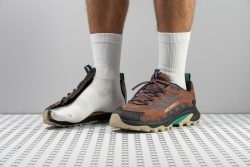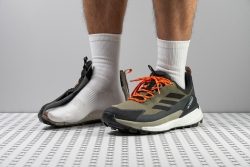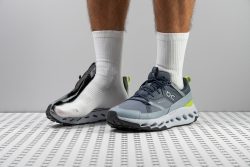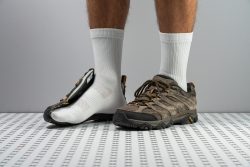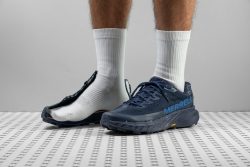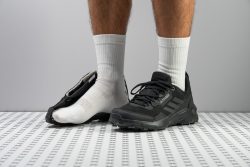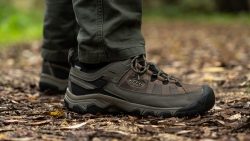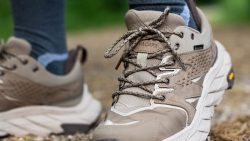7 Best Hiking Shoes For Women in 2025
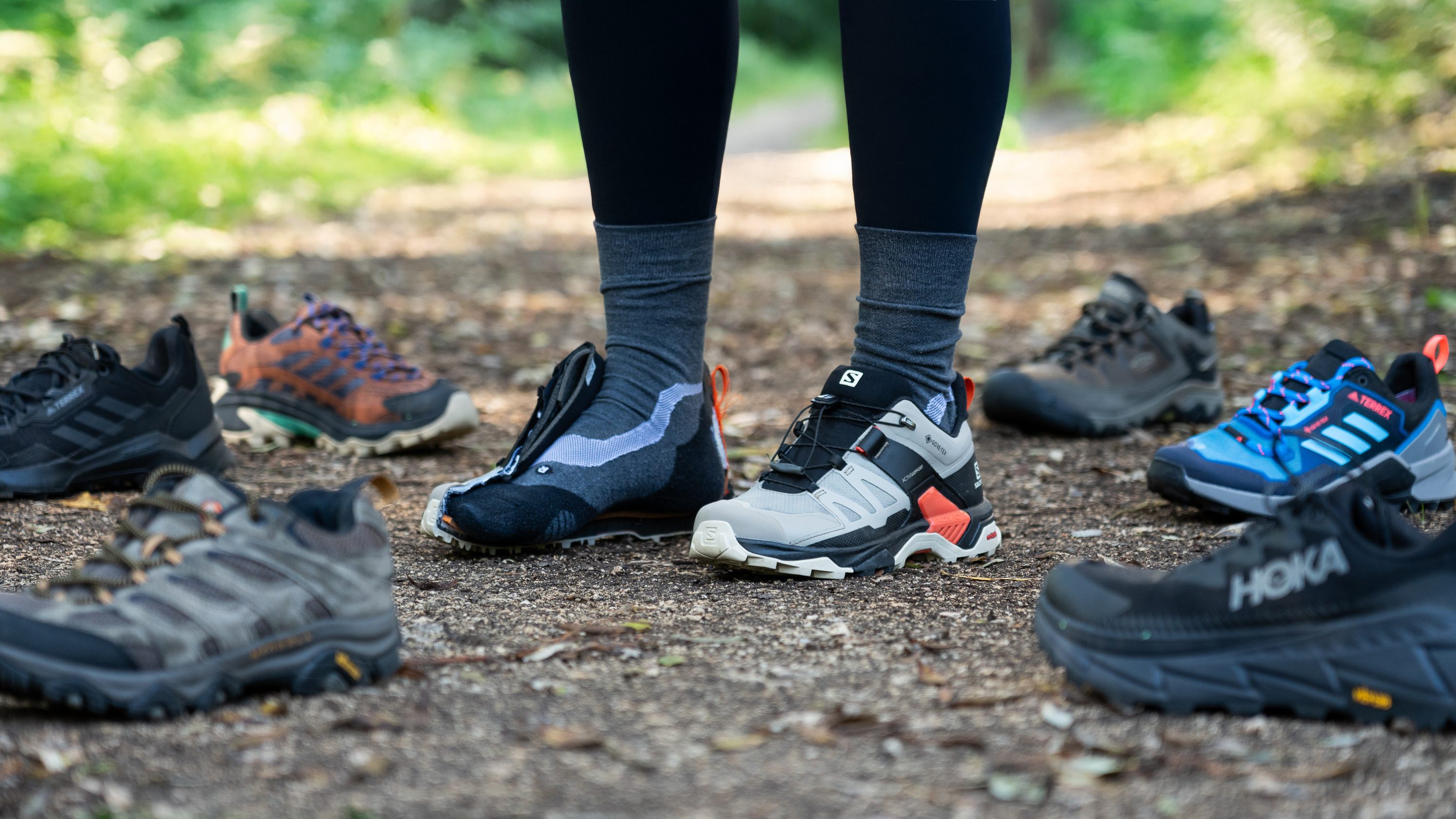
We buy shoes ourselves. We earn commissions when you buy through us, at no extra cost. Why trust us
Having tested many hiking shoes for women, both out on the trails and in our shoe lab, we're super proud to highlight the best of the best here: hiking shoes that can level up your game out in the wild.
Do you need something agile yet fully capable of hauling a moderately heavy pack? Or something that looks good even when for a restaurant? Or something rugged and super durable? What about an ultra-affordable shoe? See our picks, we've got you covered.
How we test hiking shoes for women
This is our process:
- We buy all women’s hiking shoes with our own money. We have no contracts with the brands, so we always write about and publish what we experience and feel.
- We do test hikes in these hiking shoes and make sure to expose them to everything, from soft loose ground and mud to rocky technical terrain and wet boulders.
- We perform a series of tests in our lab and publish all the data. We use callipers, durometers, a smoke machine, a liquid gel, and other tools to perform our standardised lab tests.
- Based on our experience and all the wear tests and lab tests we're able to select the best performers in different categories.
Best lightweight hiking shoes for women overall
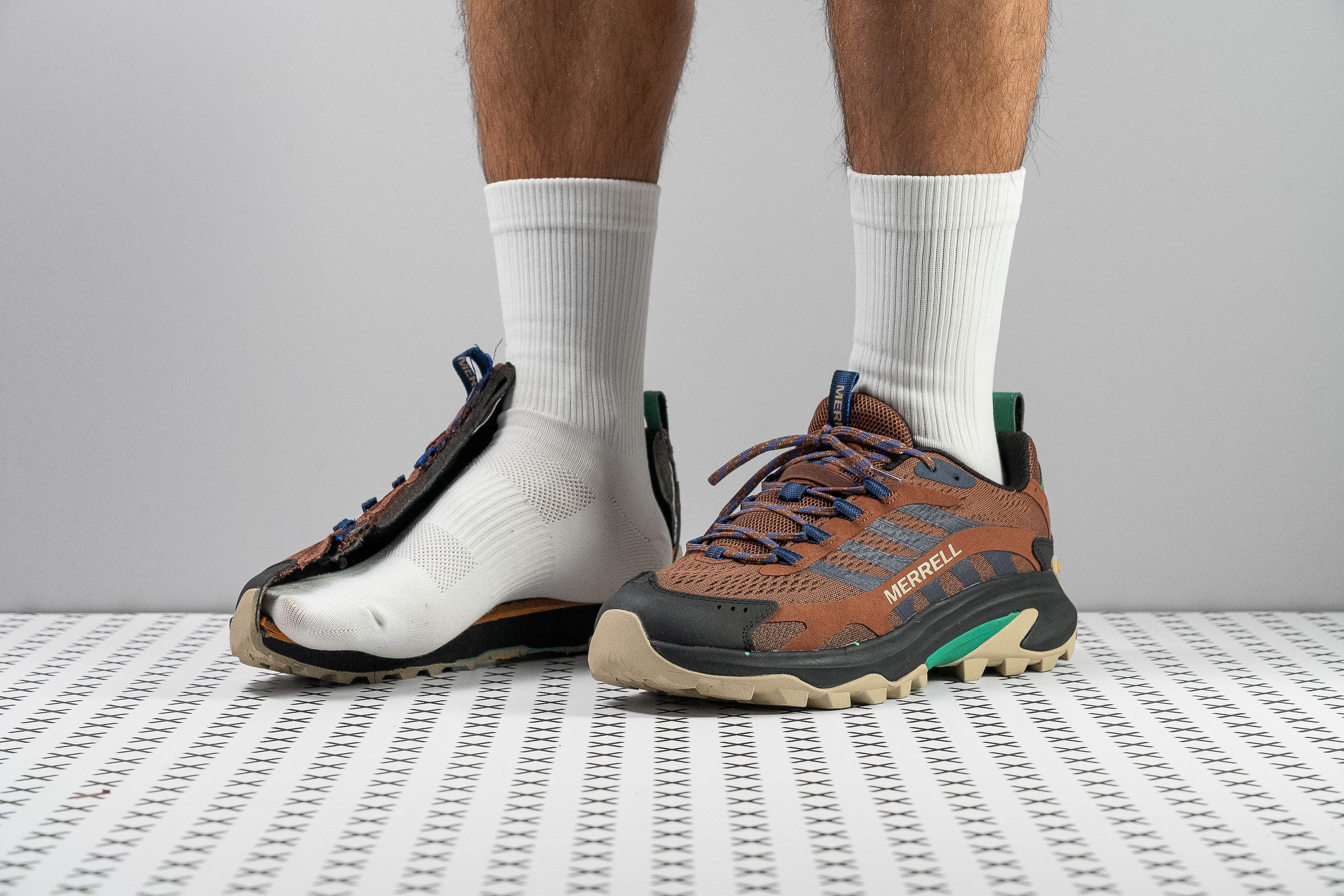























































What makes it the best?
It felt natural to pick up the pace in the Merrell Moab Speed 2. Like a trail shoe, it’s exceptionally light and fast while retaining the support of hiking shoes. Plus, we truly enjoyed its plush cushioning, making it our best women’s hiking shoe in the lab.
Moab Speed 2 offers a nimble and effortless experience. Weighing only 11.6 oz (329g), it’s 13.4% lighter than the average hiking shoe.
This low figure becomes even more impressive once we measure the stack to be a massive 38.8/23.8 mm vs. the 32.8/22.0 mm average. Testing for the full-length FloatPro Foam’s impact protection, we confirmed its gentle nature with a high 125 SA score.
What’s also surprising is how surefooted we were during testing. The midfoot area includes the FlexPlate, extending back to the heel for controlled movements. The firm Vibram TC5+ rubber embraces the midsole and never falters in its grip during testing. It's dotted with 3.7 mm lugs that further secure our footing.
However, we prefer having a fully gusseted tongue to avoid small dirt and pebbles from getting in. Women with the same sentiments should check alternatives.
Pros
- One of the lightest hiking shoes
- Plush and abundant cushioning
- Great support and stability
- Perfect grip for moderate terrain
- Excellent durability
- Breathable for summer
- Cosy step-in feel
- Two loops for easy on-off
Cons
- Frail inner lining
- Small debris gets inside
Women's hiking shoes with the best shock absorption
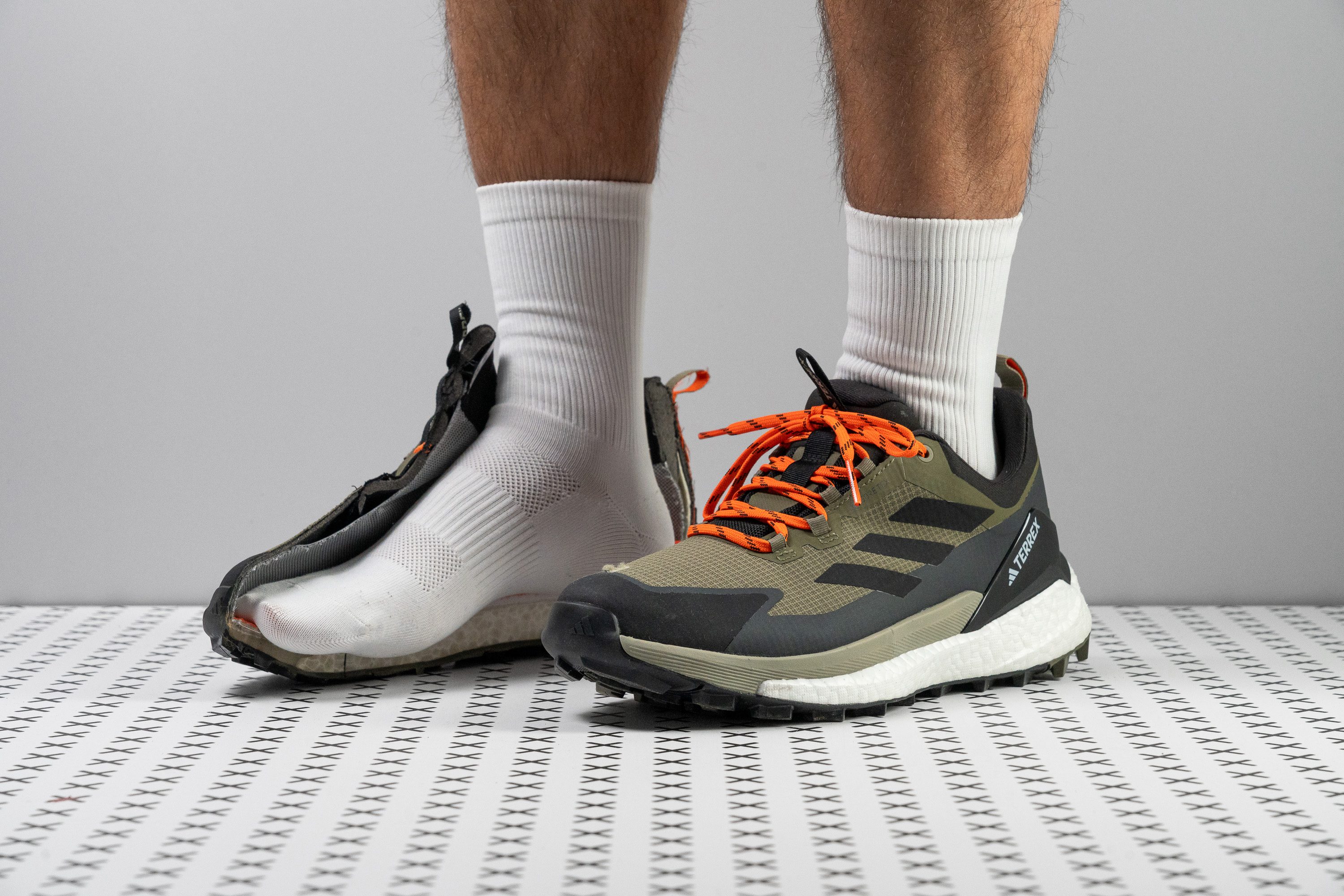



















































What makes it the best?
The Adidas Terrex Free Hiker 2.0 Low GTX allowed us to glide through the trails with its plush yet stable and bouncy cushioning. It spoiled our feet over the miles and even delivered energy return for speeding up. Our lab results show it’s a pure joy to be in with its top-level shock absorption among women’s hiking shoes.
The midsole feels luxuriously comfortable, erasing the ground and other debris. Our lab reveals a massive 37.2/24.6 mm stack. Testing for its ability to reduce landing impact, it scored a massive 126 SA, reducing stress 21.2% better than average.
When we wanted to pick up the pace, the platform offered a nice spring. In our energy return test, it impressed us with 65.9% bringing a soothing yet vibrant energy to our adventures.
Amazingly, despite its maximalist and plush nature, the ride feels impressively stable. Besides the midsole sidewalls, we found a Pebax plate between its dual-density foams to support our foot arch and keep us centred.
However, its bulky 15.7 oz (445g) build becomes apparent when we try to speed hike. Those looking for a light and agile ride should go for another pair.
Pros
- Well-cushioned and responsive
- A tonne of impact protection
- Rockered sole makes the ride smoother
- Barely gets firmer in low temperatures
- Excellent support and side-to-side stability
- Top-notch waterproofing
- Highly durable (especially the outsole)
- Ideal grip for technical terrain
- Sustainable materials (20%)
Cons
- Much heavier than average
- TPU heel clips may cause rubbing
Best city-to-trail hiking shoes for women
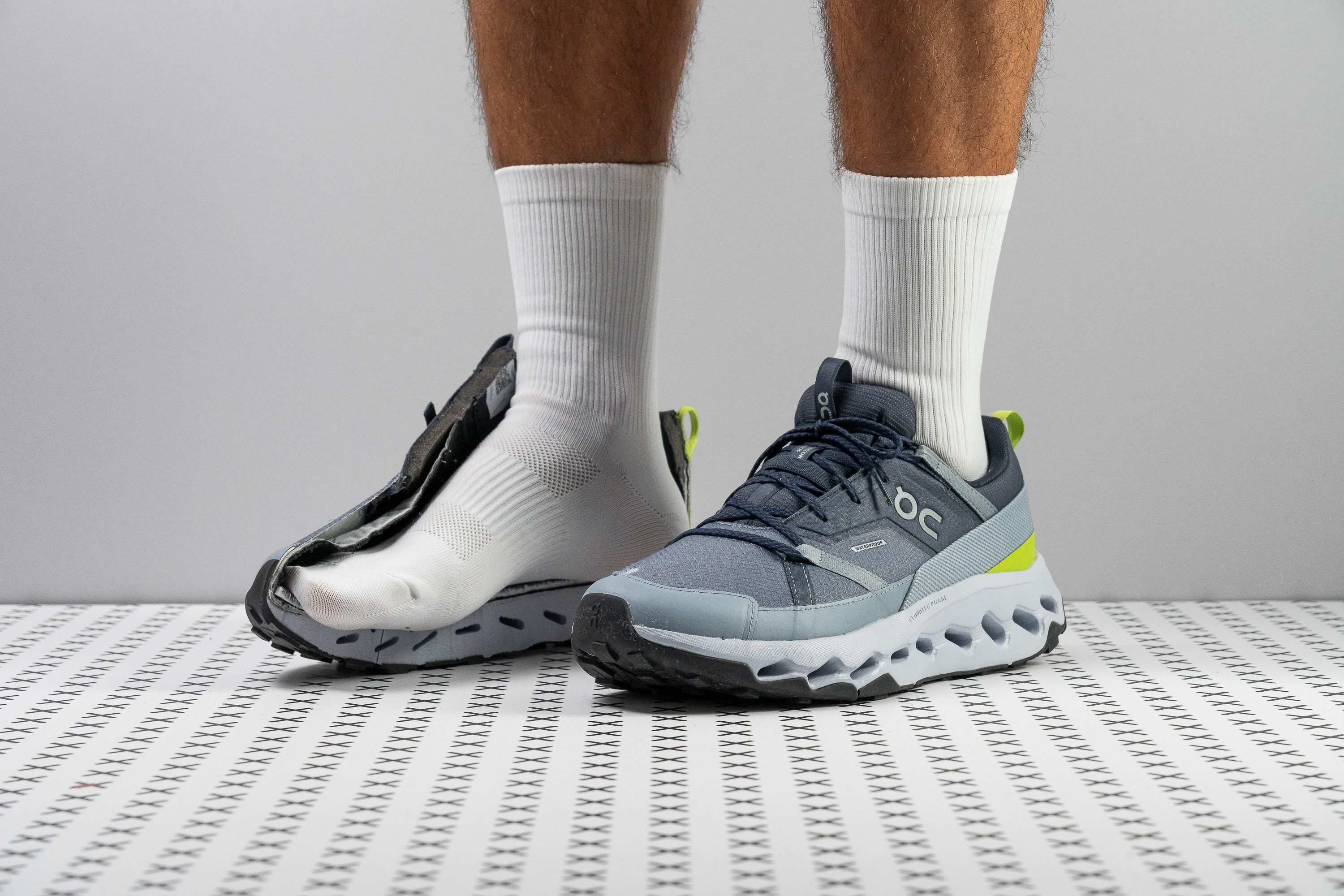





















































What makes it the best?
The On Cloudhorizon Waterproof is protective all around, from its impermeable upper, shock-absorbing midsole, and stable platform. Even as we moved from one surface to the other, we felt secure in our strides. Our lab assessment shows the Cloudhorizon Waterproof's lightweight build makes it suitable for mindless strolls, making it our best city-to-trail hiking shoe for women.
Our microscope shows the upper is incredibly dense and compact, blocking out light and, more so, water. Not a hint of smoke could escape in our lab test, proving its airtight nature with the lowest 1/5 breathability score.
We felt sure-footed throughout our hikes on uneven paths and under heavy packs. Cloudhorizon Waterproof features a broad and twist-resistant base. Our calliper measurements show it’s 116.3/89.1 mm wide, while our manual assessment earns the midsole a high 4/5 torsional rigidity score.
This shoe is all about maximising comfort and reducing fatigue, with its plush cushioning and light build. We measured the stack height at 39.4/29.2 mm, with a remarkable shock absorption of 126 SA. Despite its sky-high cushioning, the shoe is only 12.0 oz (339g). With 10.8% weight savings compared to the average, it’s easier to bring around.
However, this On shoe is expensive at £190. Women who prefer a more affordable hiking shoe should explore alternatives.
Pros
- Effective waterproofing
- Abundant cushioning and impact protection
- Lively and responsive ride
- Amazingly light for its stack and waterproofing
- Great as a city-to-trail shoe
- Good stability for moderate terrain
- Comfortable in-shoe feel
- True to size and fit
Cons
- Not for serious hiking
- Lacks durabiity for the price
Best women's hiking shoes with a wide toebox
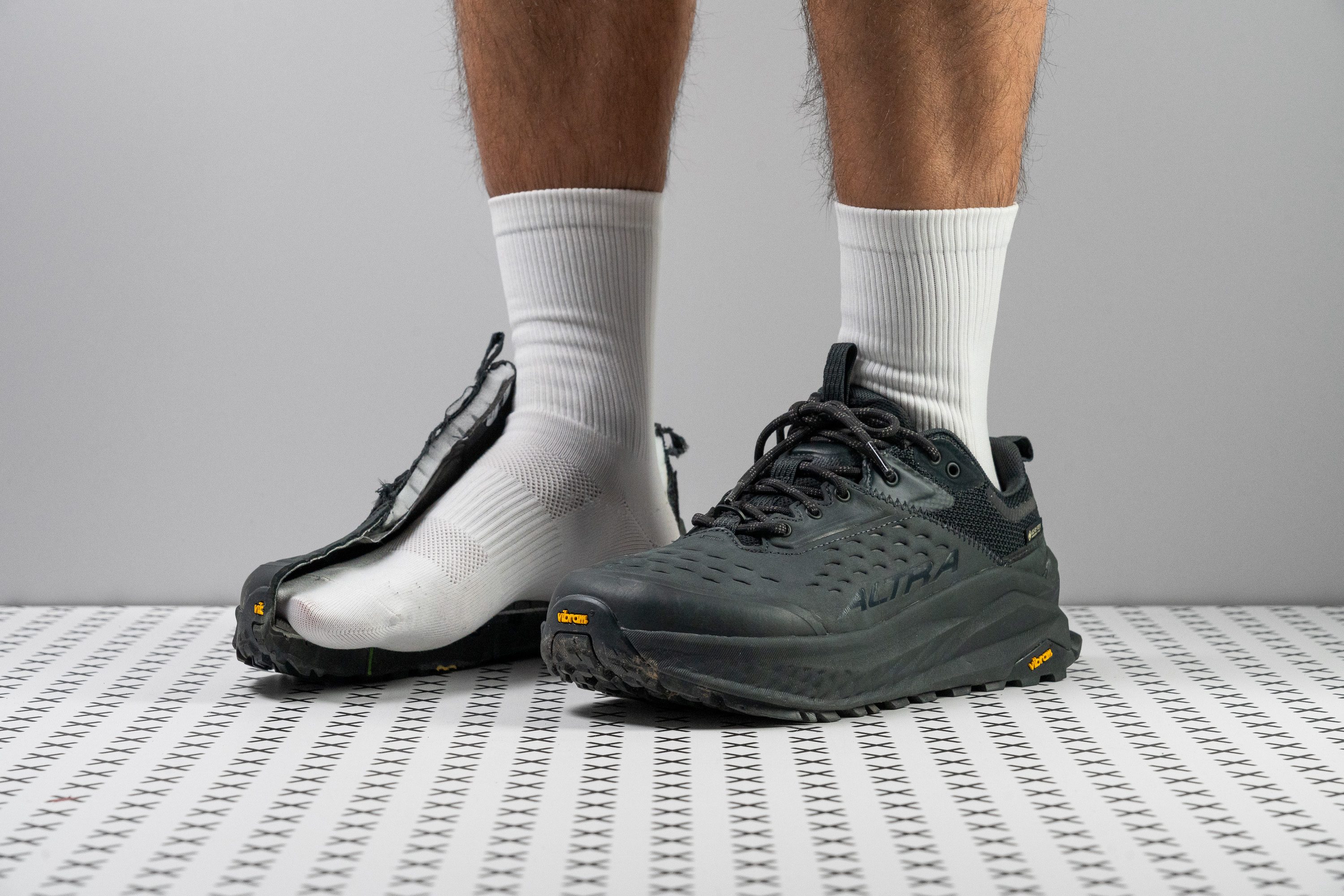
















































What makes it the best?
On our multi-day hikes, we lean towards a comfortable, protective, and accommodating pair of shoes—and if they are waterproof, much better. Incredibly, the Altra Olympus 6 Hike Low GTX ticks all those boxes and more, leading us to choose it as our best with wide toebox hiking shoe for women.
Starting with the highlight, this Altra features the Original FootShape Fit, and we created a gel mould to verify this. Our calliper shows one of the roomiest toeboxes we’ve seen at 80.5 mm, 11.0% wider than average! It easily accommodates women with square-shaped or swollen feet.
The nubuck leather upper also features the Gore-Tex Invisible Fit membrane, providing a double-layer shield against water and cold winds. Indeed, it received the lowest 1/5 score in our breathability test.
The platform feels well-cushioned underfoot, with a hint of spring that makes the ride more enjoyable. Testing for shock absorption, we recorded an above-average 118 SA, explaining why our legs didn’t feel too beaten up after long treks. Moreover, we verified its above-average energy return of 55.7%.
However, women who prefer a lightweight ride should skip this pair. At 14.4 oz (408g), it’s 7.4% heavier than average.
Pros
- Excellent shock absorption
- Comfortably soft cushioning
- Ultra padded and cosy step-in feel
- Exceptionally wide fit and footshaped toebox
- Extra wide and stable platform
- Highly durable leather and outsole
- Excellent grip on smooth and wet rocks
- Solid waterproofing
Cons
- Not a true zero-drop (1.5 mm)
- Midsole gets notably firmer in cold
- Frail inner lining
Women's hiking shoes with the best comfort



































What makes it the best?
We felt like hiking endlessly in the Merrell Moab 3 GTX. It served as our defence against foot pain, rain, and other forms of debris underfoot. Our lab confirms it’s tough on the outside yet gentle on the inside, making it our most comfortable hiking shoe for women.
During our initial wear, we felt instant comfort in this shoe. It has ample cushioning underneath to protect our feet, measuring 33.2/22.3 mm. Our durometer shows the foam is a firm 35.9 HA, but is more comfortable than the figure suggests because of the midsole’s shock absorption and responsiveness that reduces fatigue. In addition, the shoe is flexible enough for effortless movement.
The tight upper is complemented by a fully gusseted tongue that effectively keeps moisture out. Our lab confirms its waterproof nature with the lowest breathability score of 1/5.
The Vibram outsole proves its status as top-tier rubber by effectively gripping any surface we tested. Traction is further enhanced by the deep 4.8 mm lugs.
What felt like a burden was the shoe’s boot-like weight of 16.0 oz (452g), 20.2% heavier than average. Women seeking a light and agile experience should look for another pair.
Pros
- Superb day-one comfort
- Brilliant surface adhesion
- Supportive like a work shoe
- Remarkably durable
- A-grade waterproofing
- Sheds mud quite well
- Protective toe box
- Incredible overall quality
- Incredible overall quality
Cons
- Heavy for a low-top
- Subpar breathability
- Its shoelaces unravel often
- Minimal shock absorption
Best lightweight summer hiking shoes for women
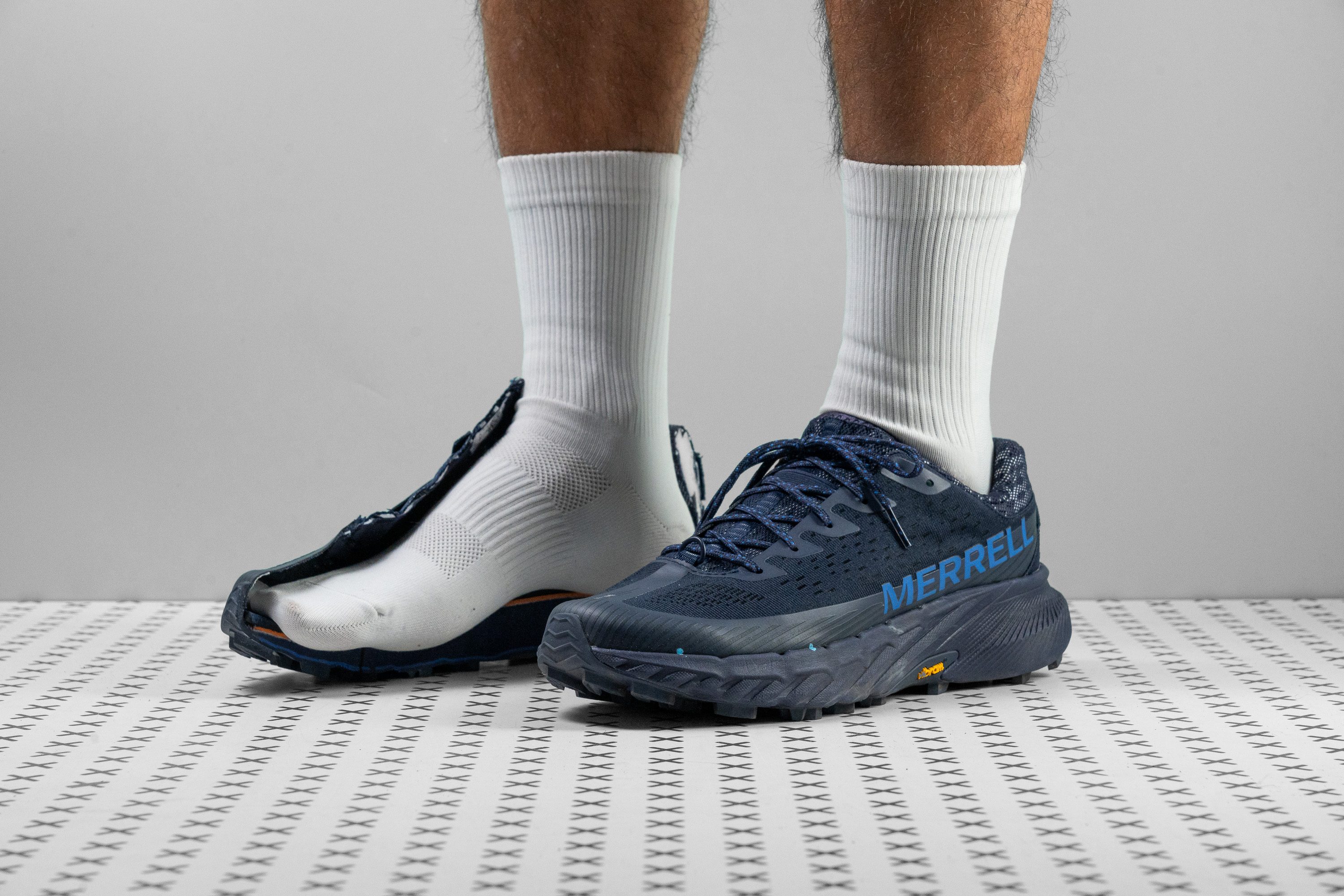















































What makes it the best?
On hikes with unpredictable trails, the Merrell Agility Peak 5 armed us with steady support and lasting comfort in a streamlined package, giving us the confidence to pursue new destinations. With its grippy Vibram rubber and secure feel, it’s our top-rated lightweight hiking shoe for women in the lab.
Weighing only 10.2 oz (289g), this shoe is light enough for running. It feels far from being a burden in our treks since the average hiking shoe weighs 23.9% more. Despite its low figure, it spoils us with abundant cushioning, notably its 39.2 mm heel.
We found the shoe’s rigid construction to be an effective stabiliser against lateral movements, which lessens fatigue on longer hikes. Our attempts to twist the shoe had no effect, earning the highest torsional rigidity score of 5/5.
In terms of grip, we had no issues during testing thanks to the deep 4.5 mm lugs. The Vibram Megagrip rubber shows reliable grip in our treks and proves its resilience in the lab by showing less damage than average in our Dremel test.
However, this shoe has a narrow midsole and toebox that may cause discomfort to those with wide feet. If a more forgiving fit is needed, we suggest looking elsewhere.
Pros
- Easily handles tough trails
- Performs well on both downhills and uphills
- Extremely durable upper with numerous TPU reinforcements
- Suitable for year-round use
- Loads of recycled, eco-friendly stuff
- Wonderful for heel strikers
- Excellent all-terrain shoe
- Excellent all-terrain shoe
- Excellent all-terrain shoe
Cons
- Grips worse than expected
- Actual drop deviates significantly from what's stated
- Feels flat underfoot
- Narrow toebox
Best budget hiking shoes for women
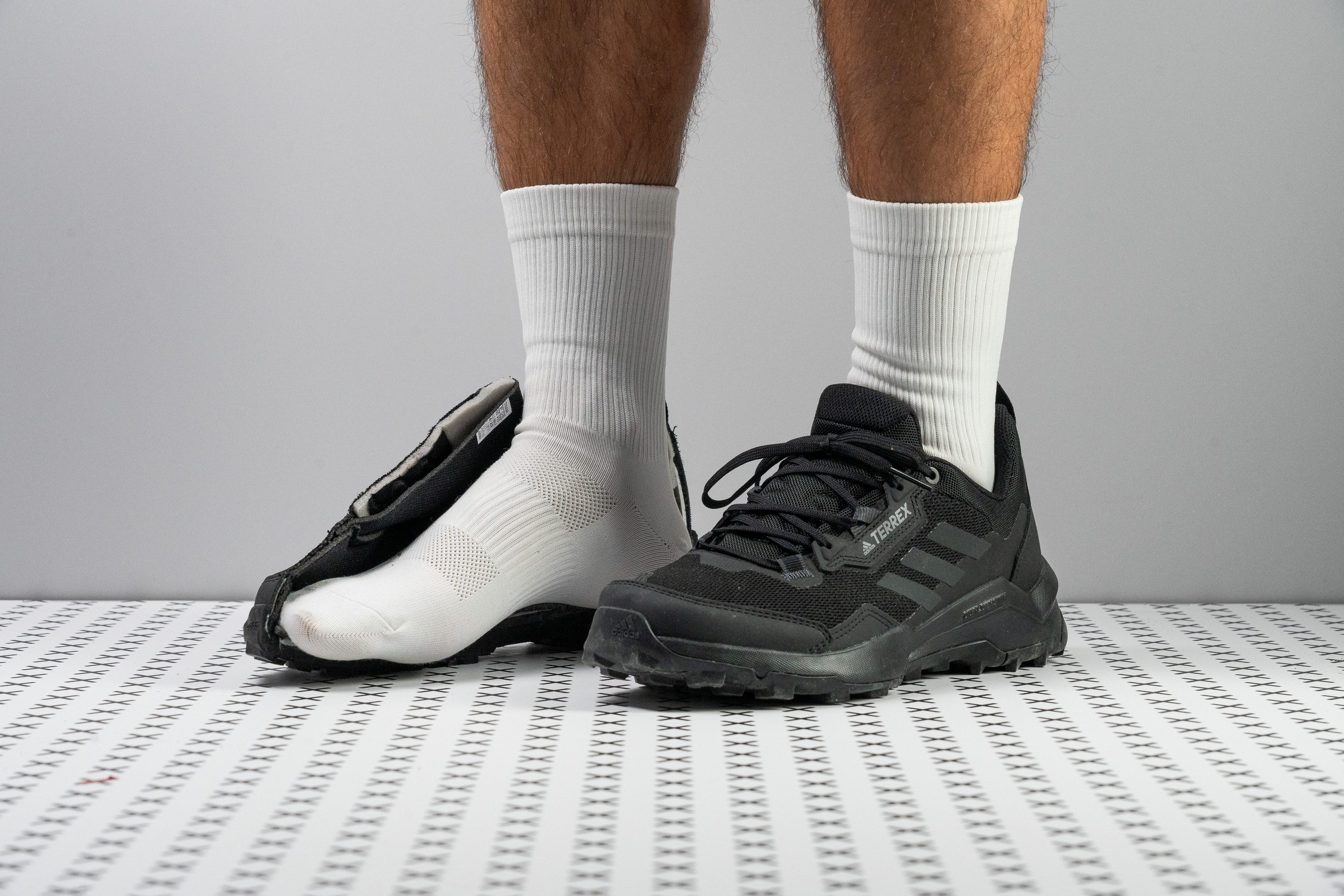







































What makes it the best?
Hiking in the mountains proves the Adidas Terrex AX4 packs comfort, agility, and stability into one £90 shoe. For reference, the average hiking shoe in our lab costs £130. It delivers reliable traction that boosts our confidence even on slippery mud, offering so much for its affordable price. It’s definitely our best budget hiking shoe for women.
The cushion offers both comfort and protection against underfoot debris, with precise stack height measurements of 30.6/20.9 mm. Being slightly below average, the shoe has more give to it, enhancing its versatility as well. Our bend test confirms it’s 20.2% more flexible than average.
The midsole doesn’t feel overly plush, which contributes to our surefootedness. It also has a wide landing base of 111.5/87.9 mm, erasing any potential spillovers and wobbles.
Underfoot, is an outsole that can handle all types of terrain. We never had instances of slipping even on wet grass and mossy logs. The 3.7 mm chevron lugs gripped the surface effectively, while the redesigned heel brake offers both skid resistance and mud-shedding capabilities.
Unfortunately, the insole is only 2.6 mm thin vs. the 5.3 mm average. The good news is women who prefer a more cushioned insole can easily replace it.
Pros
- Excellent value for money
- Feels like a trail running shoe
- Breathable
- Water-repellent
- Excellent grip
- Durable for the price
- Stable platform
- Contains recycled materials
Cons
- Lacks toe protection
- Flimsy insole
- Aggressively tapered toebox
Double-check: are hiking shoes exactly what you need?
Best to get this out in the open immediately. Hiking shoes are great, but we will offer scenarios here when you might want to look into different footwear. Let’s double-check, just in case:
- Trail running shoes: if you want something very agile and flexible, this is the footwear to choose. Best to find a proper pair of trail running shoes if you like moving fast and light and if you maybe even run a few sections on the hike.
- Hiking boots: if you feel like your ankles need extra support, hiking boots are the best because they hug the ankles properly. Not just that, they offer more support and stability for carrying heavier loads (backpacks).
All set with the hiking shoes? Let’s dive in.
The difference between women’s and men’s hiking shoes
Women and men don’t have the same feet anatomically, so it’s great when we can choose and actually buy women’s shoes, not just men’s shoes in smaller sizes. And, eventhough we know that women usually have a wider toebox and a narrower heel, brands don’t feel the same way.
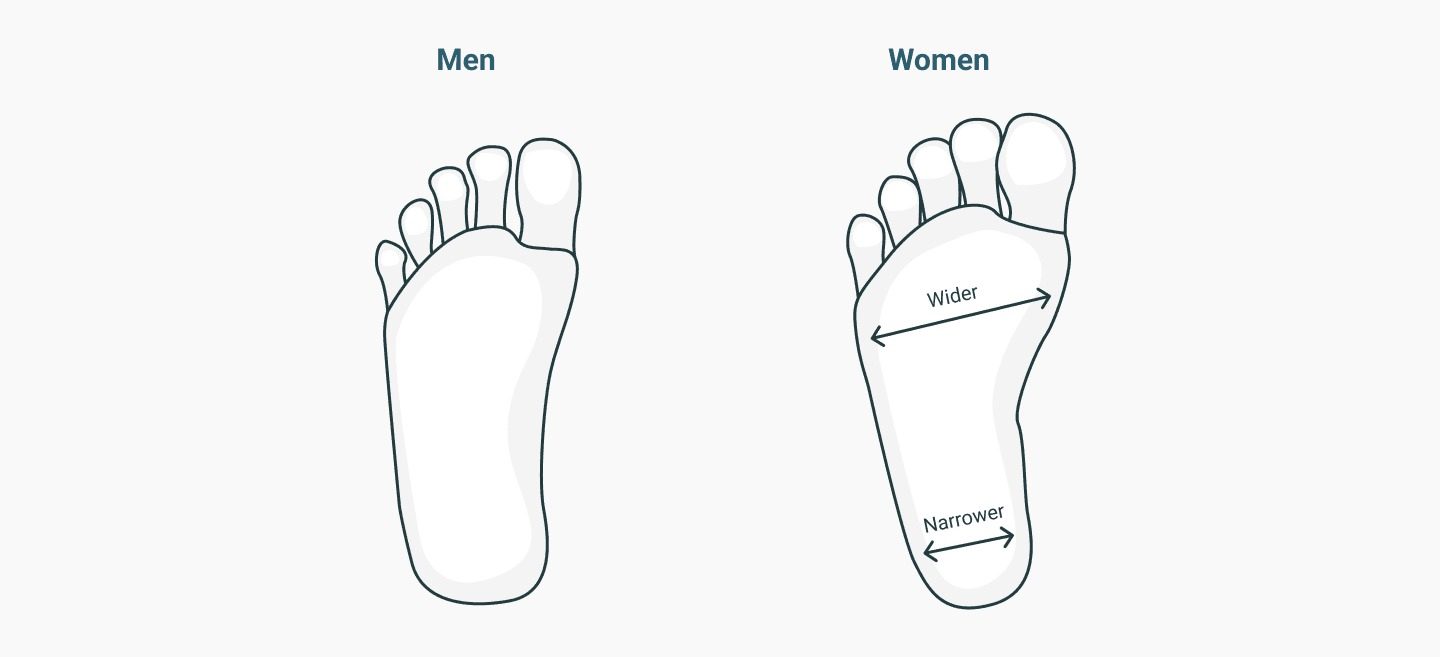
That means that it’s up to the brand to decide how they will make the shoes different. In most cases, women’s shoes are narrower than men’s. Unfortunately, sometimes it is just about the difference in length (size).
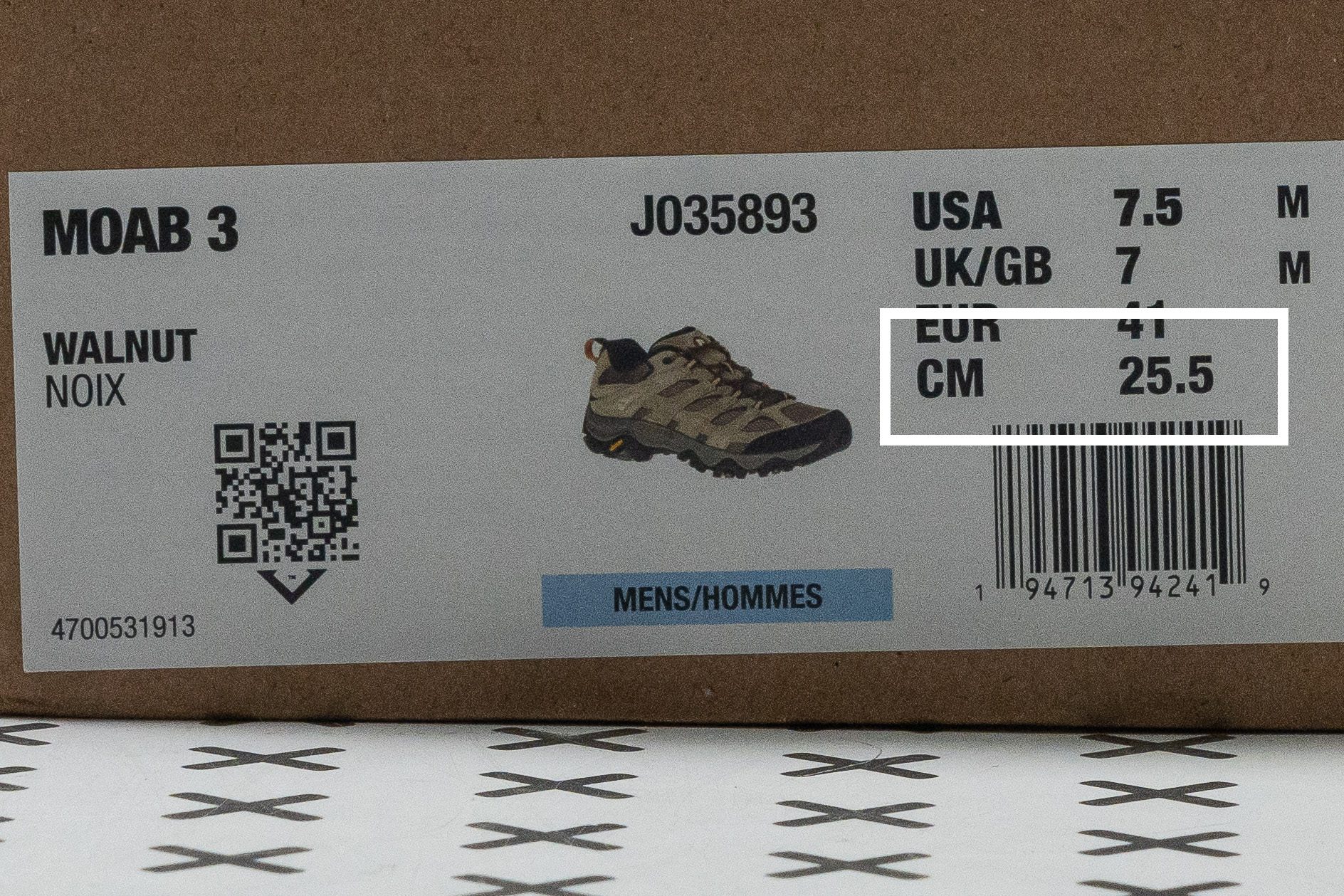
If you’re considering buying men’s shoes, the best way to nail the size is to look at the length given in centimetres (cm) and find the size that corresponds to the length of your feet. Or, use our size charts (we have them for dozens of brands).
3 most important things to know when buying hiking shoes
There are many things one can pay attention to when buying hiking shoes, but here we focus on 3 parent topics. Once we define them, the rest will follow:
- How to nail the fit
- Hike difficulty: light, moderate, or technical? Once this is defined, we can easily cover other features like grip, stability, and stiffness and which levels are needed for more or less demanding hikes.
- Season. Knowing when and in what type of weather you plan to hike will help us find the upper needed for those occasions: very breathable, quick-drying, very warm, and/or waterproof.
Let’s start.

How to make sure hiking shoes fit properly?
Here’s a 6-step guide we highly recommend:
- Make sure to try the shoes on later in the day. We’re aiming for that swelling that happens naturally as the day progresses but also when we’re hiking.
- When trying the hiking shoes on, use the socks you plan to hike in and orthotics if you’re using them.
- Once the hiking shoes are all laced up, look for hot spots. The shoes should not be too tight nor too wide. We’re looking for a superb lockdown, meaning your feet should not be sliding to the sides or forward/backward on uneven terrain. And, your heel must not be slipping.
- If you’re trying the shoes on in a specialty store, test them on the ramp and different surfaces (cobblestone, artificial grass, etc.). These will give you the best impression of how good the lockdown is.
- When the fit is right, you should be able to stick your thumb behind the heel when you push your foot forward to reach the edge of the toebox.
- The last thing to keep in mind is that many hiking shoes need to be broken in. Some might feel stiffer at first (especially the leather ones). The best advice is not to rush to a multi-day demanding hike in your new hiking shoes. Use them on a few shorter hikes first.
Wide toebox in women’s hiking shoes: lab data
If you’re among women who need more space in the toebox, this is the best spot in the world for you. Here, we will highlight our lab data and list hiking shoes with the widest toeboxes.
In most cases, you'll see some estimates on the width or measurements done on the outside. The downside is that those don't include (or exclude) the width of the upper, the thickness of the protective overlays, thick toe bumpers, etc. To deal with this, we came up with a unique gel formula!
Once it's settled and hardened, we take the gel mould out and take calliper measurements.
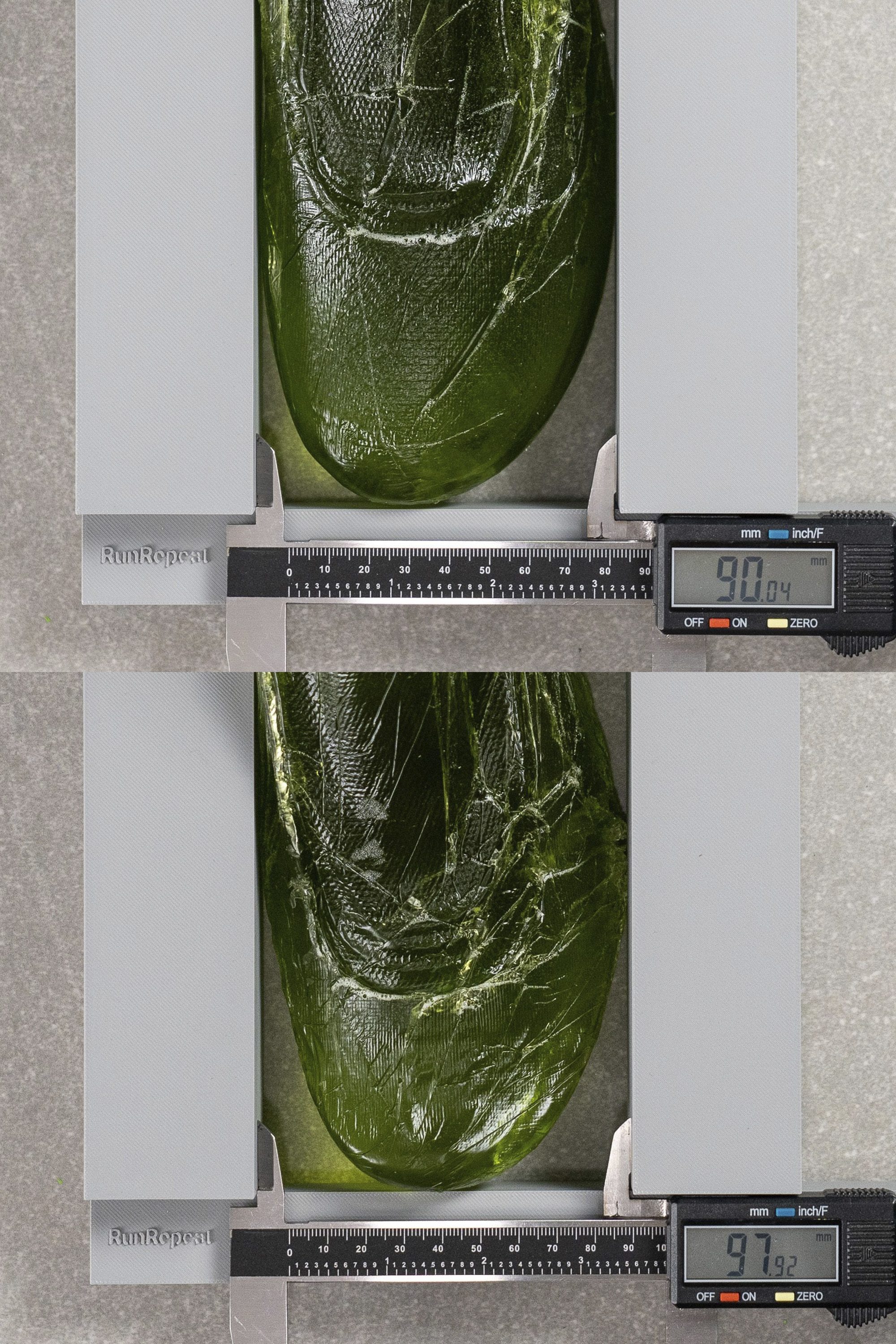

The bigger numbers on the digital calliper here tell us that the toebox is less pointy or more foot-shaped.

Why do we make both measurements? Because there are many different shapes of toes and we want all women to be able to look for the width that they actually need and where they need it in a hiking shoe.
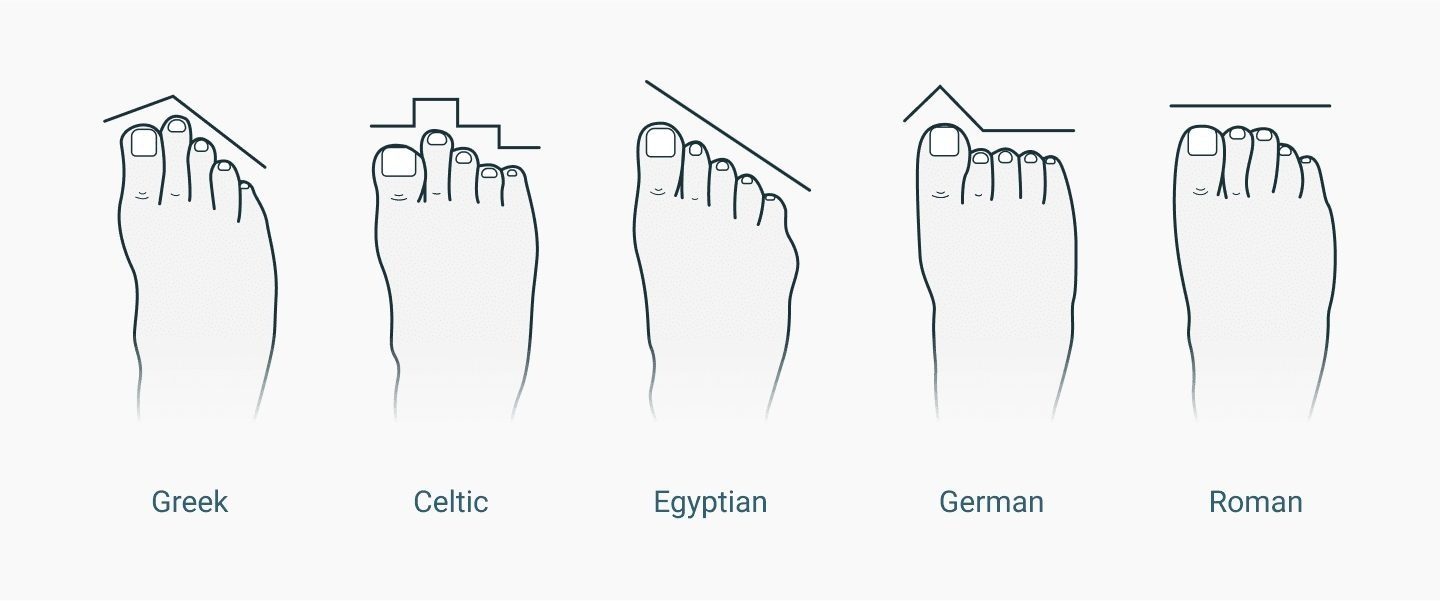
Those with Egyptian shapes will look for more width where the shoe is the widest, while those with Celtic and German shapes will look for more width at the big toe.
We know that having high-volume feet may also mean you need vertical room, not just horizontal. So, we measure the height of the toebox as well.
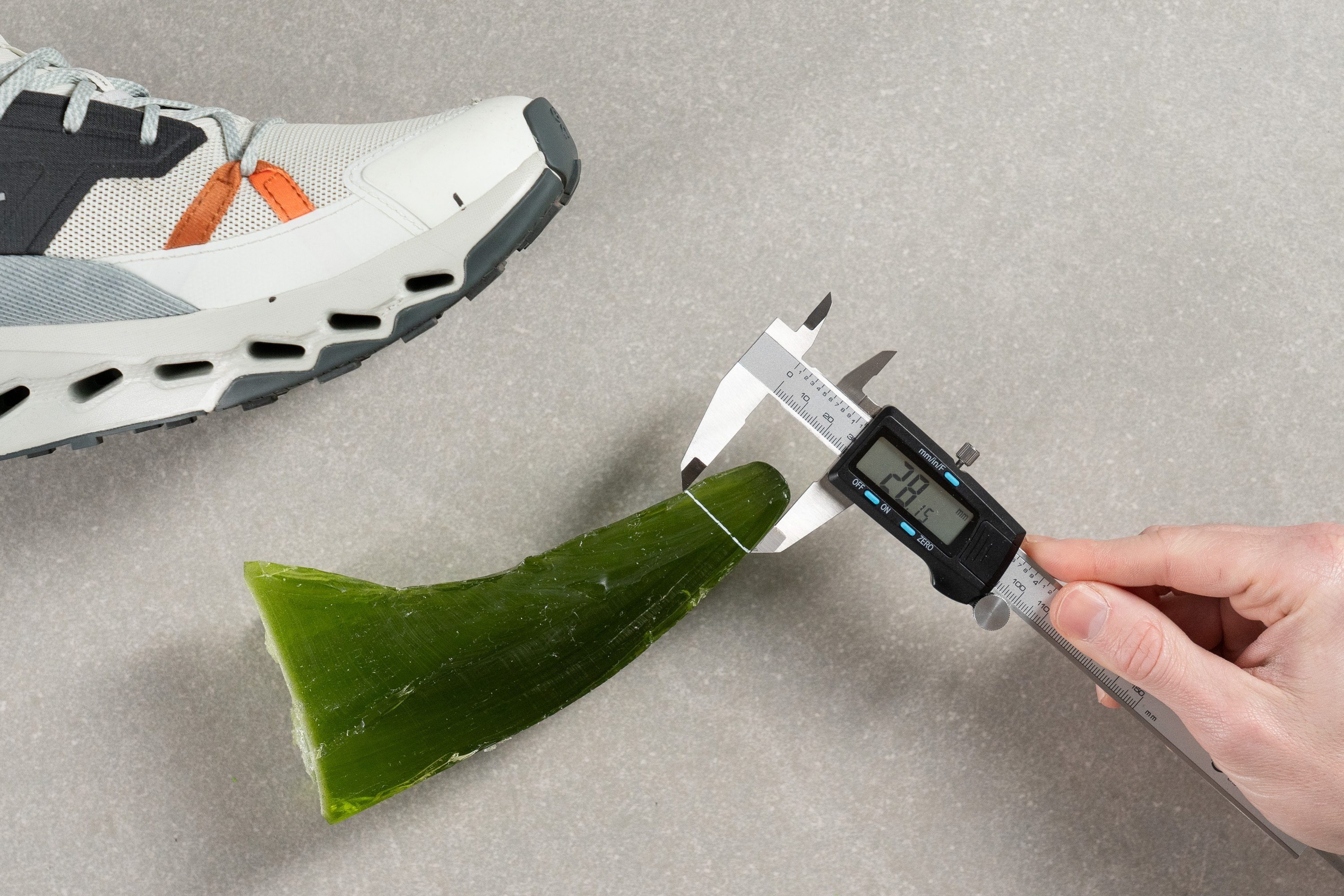
If you have already experienced pressure from the top on your toes, this is the measurement to prioritise.
Light, moderate, or technical hiking shoes?
While there are many types of hikes: fast and light, multi-day, muddy, covering large boulders or flat rocks, etc., we realised it’s best to talk about 3 groups at first: light hiking, moderate hiking, and technical hiking.
Look at the table below to understand how they are different and why, depending on the hike difficulty, we recommend different features:
|
Light |
Moderate |
Technical |
|
|
Use |
Short, easy hikes, with no backpacks or very light ones |
All-day hikes or multi-day hikes, backpacking |
All-day hikes or multi-day hikes, backpacking |
|
Surface |
Road-to-trail, urban environments, hard-packed trails |
All trails except the demanding, technical ones |
Mud, rocks, slush, trails covered with tree roots and debris, etc. |
|
Grip |
Shallow lugs |
Average lugs |
Deep lugs |
|
Durability |
Can be the least durable, usually not protective |
Durable |
The most durable and protective |
|
Stiffness |
They can be quite flexible |
Flexible to stiff |
Very stiff to avoid wobbling on demanding terrain |
|
Stability |
Can be less stable |
Stable |
Very stable and supportive |
On our website, you can find a filter for hike difficulty and filter out the hiking shoes by them.
Grip in women’s hiking shoes
Grip in hiking shoes depends on the: lug thickness, number of lugs and distance between them, shape and orientation of the lugs, and rubber hardness. Usually, the grippiest shoes feature very deep lugs and softer rubber. Harder rubber is more durable and protective and is usually found in hiking shoes for harder surfaces.

Very generally speaking, women’s hiking shoes for light hiking feature lugs shallower than 3mm, moderate hiking ones 3-4mm, and hiking shoes for technical terrain have lugs deeper than 4mm.
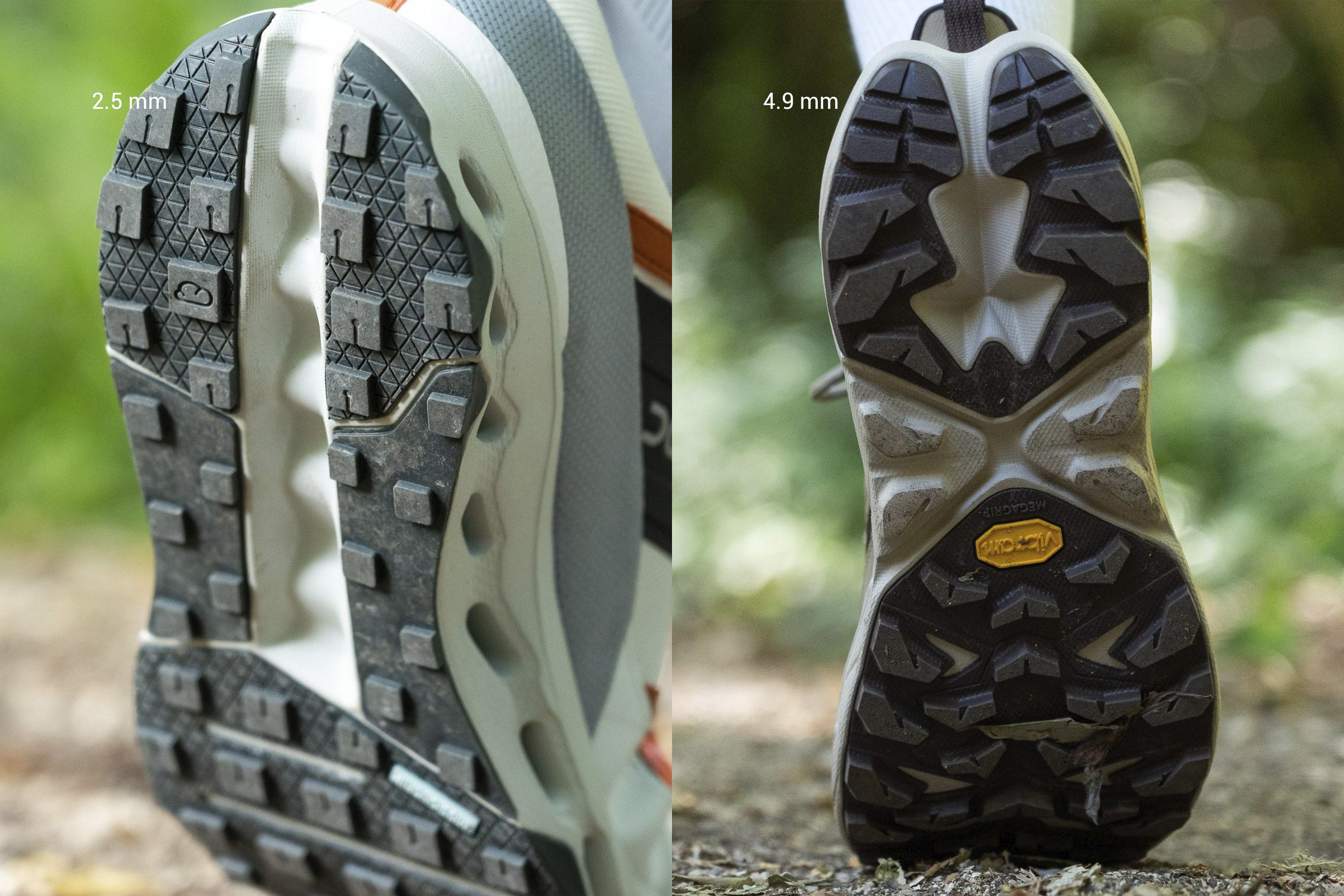
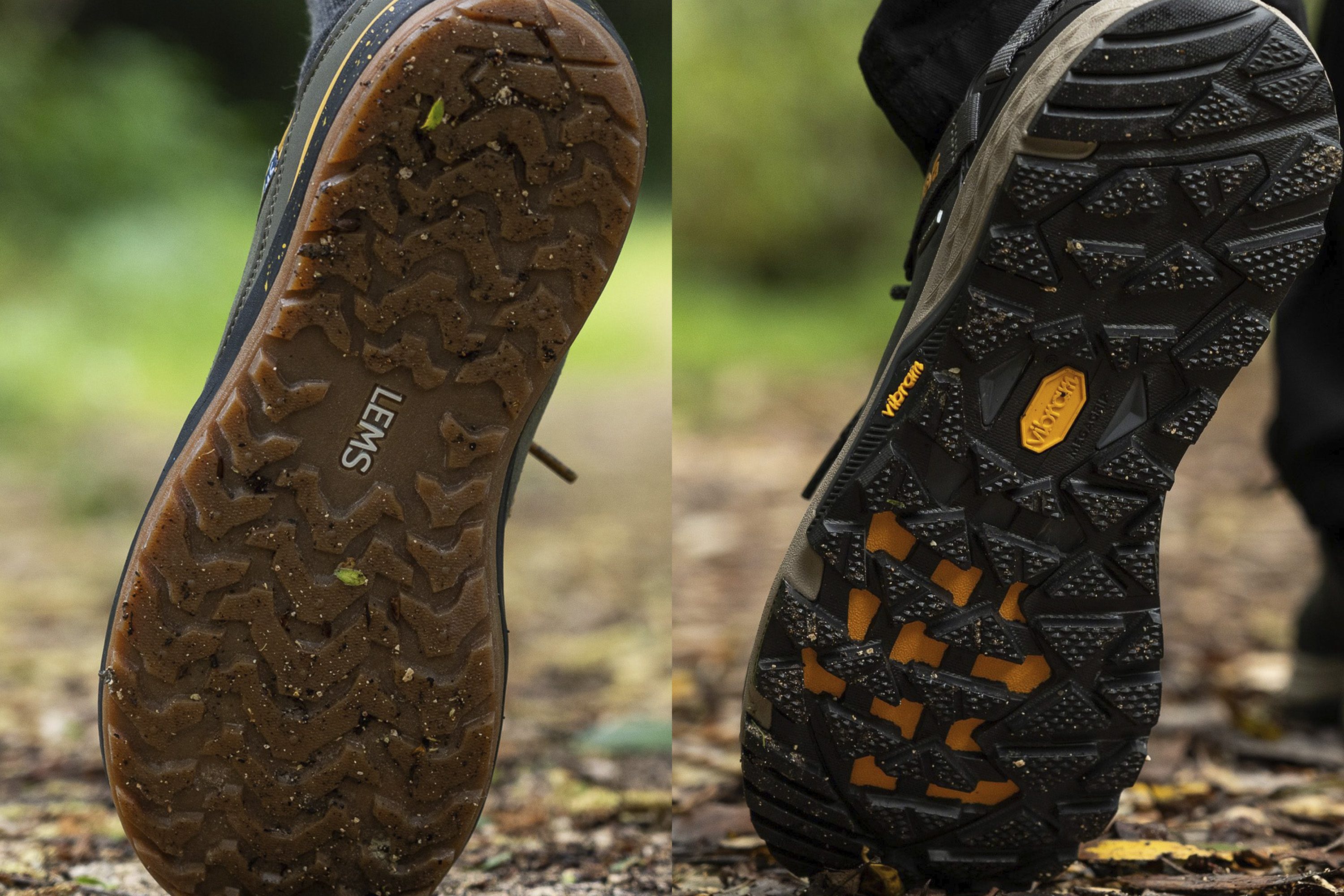
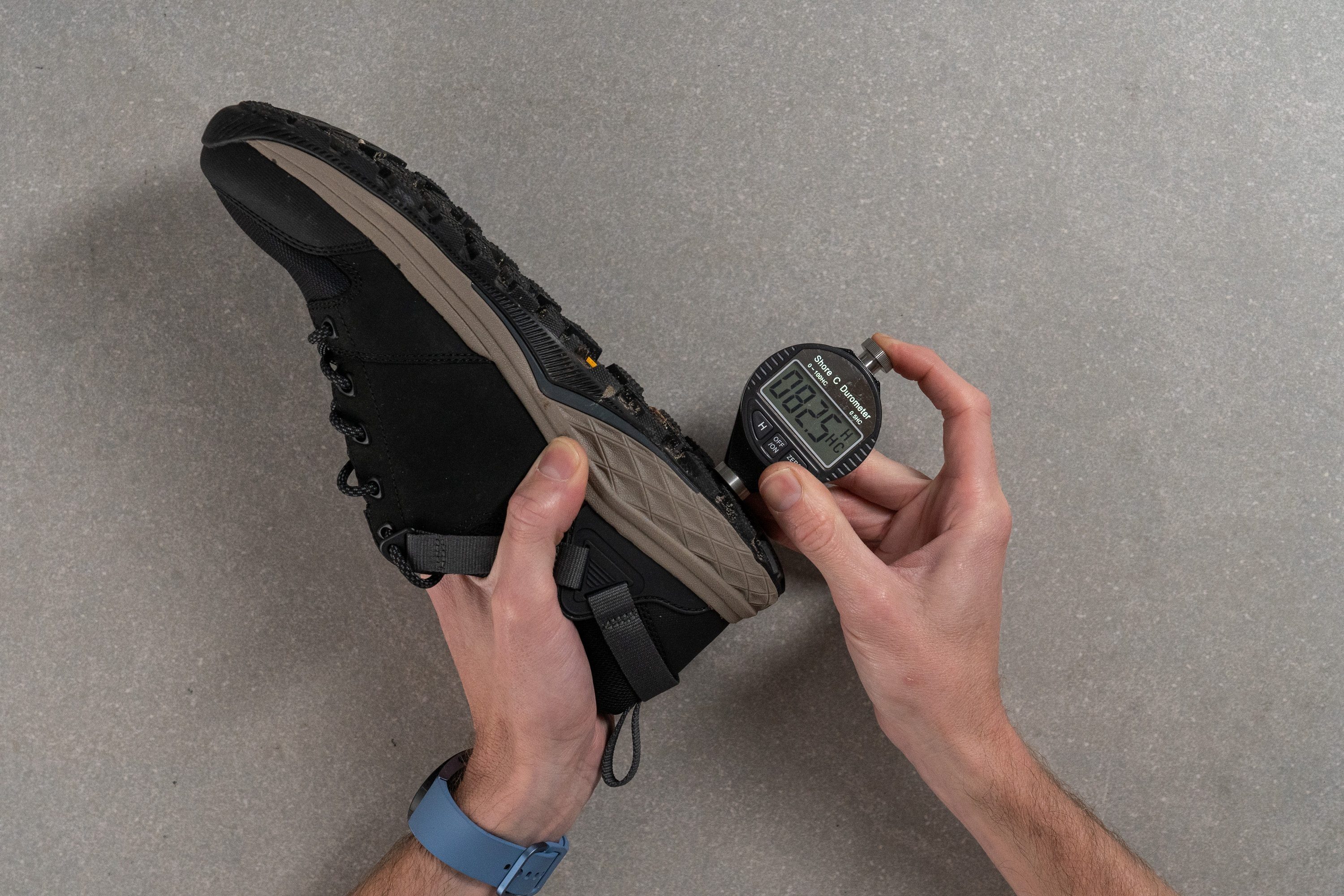
When looking at the durometer, it’s important to know that higher numbers indicate a harder rubber. Harder rubber offers more protection and stability and it’s usually more durable. Softer rubber gets lower numbers on the durometer and it’s more flexible, pliable, and stickier.
Shock absorption of women's hiking shoes
There are 2 cases when shock absorption is often overlooked: a) when talking about comfort, because many focus on the softness of the midsole only, and b) when talking about protection, because often protection is about the trail and weather conditions only.
Let's put an end to this right now: hiking shoes with good shock absorption feel great because they offer a lot of protection from impact forces. That means that hiking shoes with high shock absorption are really good at dampening the impact when you land on the midsole with your heel.

If they were bad at it, your legs would certainly feel a lot more strain, which would end up in premature fatigue and maybe even foot pain.
The most durable hiking shoes for women
Women who want the best protection for their toes look for the most durable toeboxes. Fortunately, we test this in our lab by pressing a dremel against the toe box. This is a standardised test, meaning we always use the same force, RPMs, and time duration.
Once we’re done with the dremel, we assess the damage on a 1-5 scale, where 1 is the least durable.
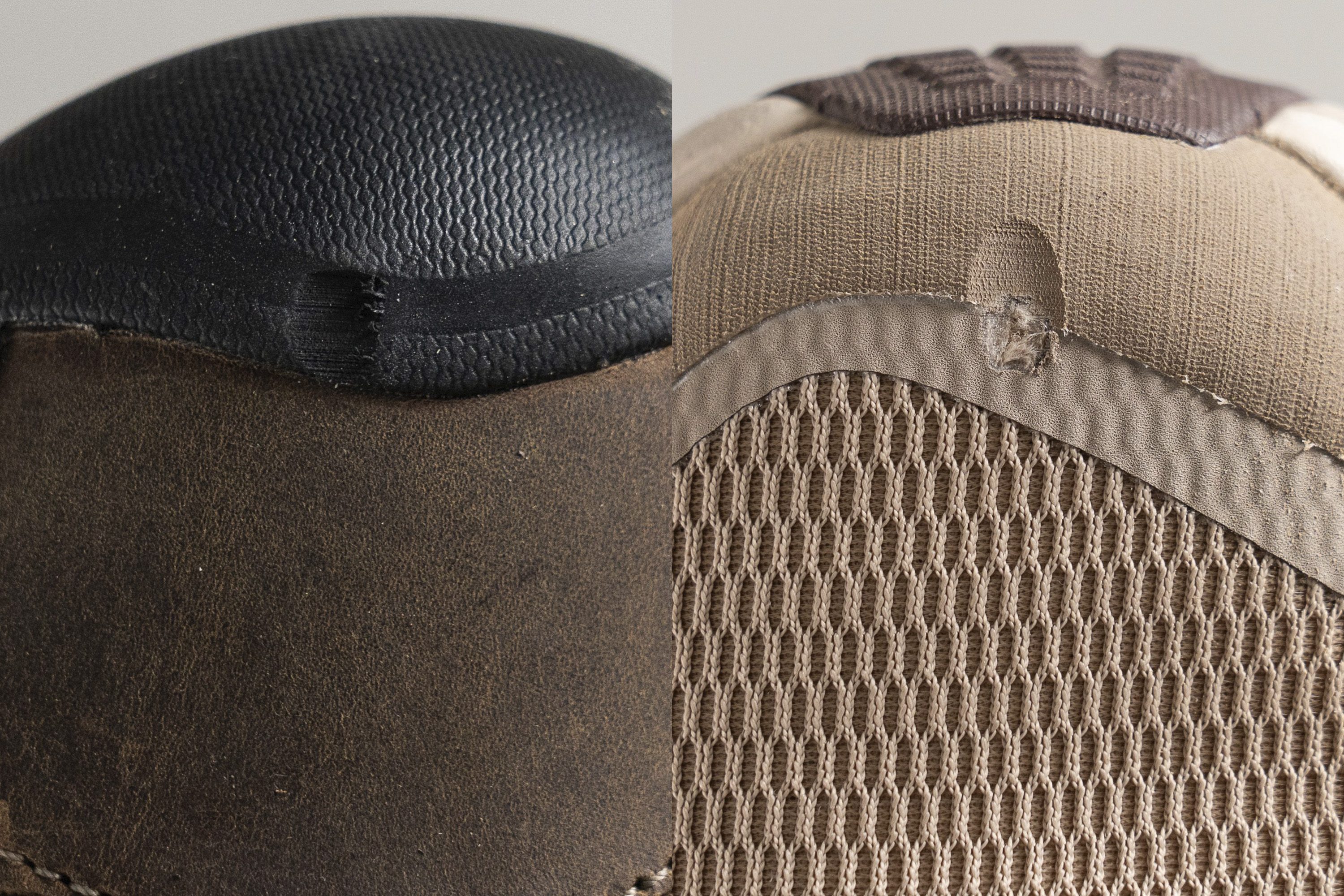
We perform the same test on the outsole, only this time, we don’t have to assess the damage. We use a tyre tread gauge to accurately measure the depth of each dent. Deeper dents indicate less durable outsoles, just like shallower dents indicate more durable ones.
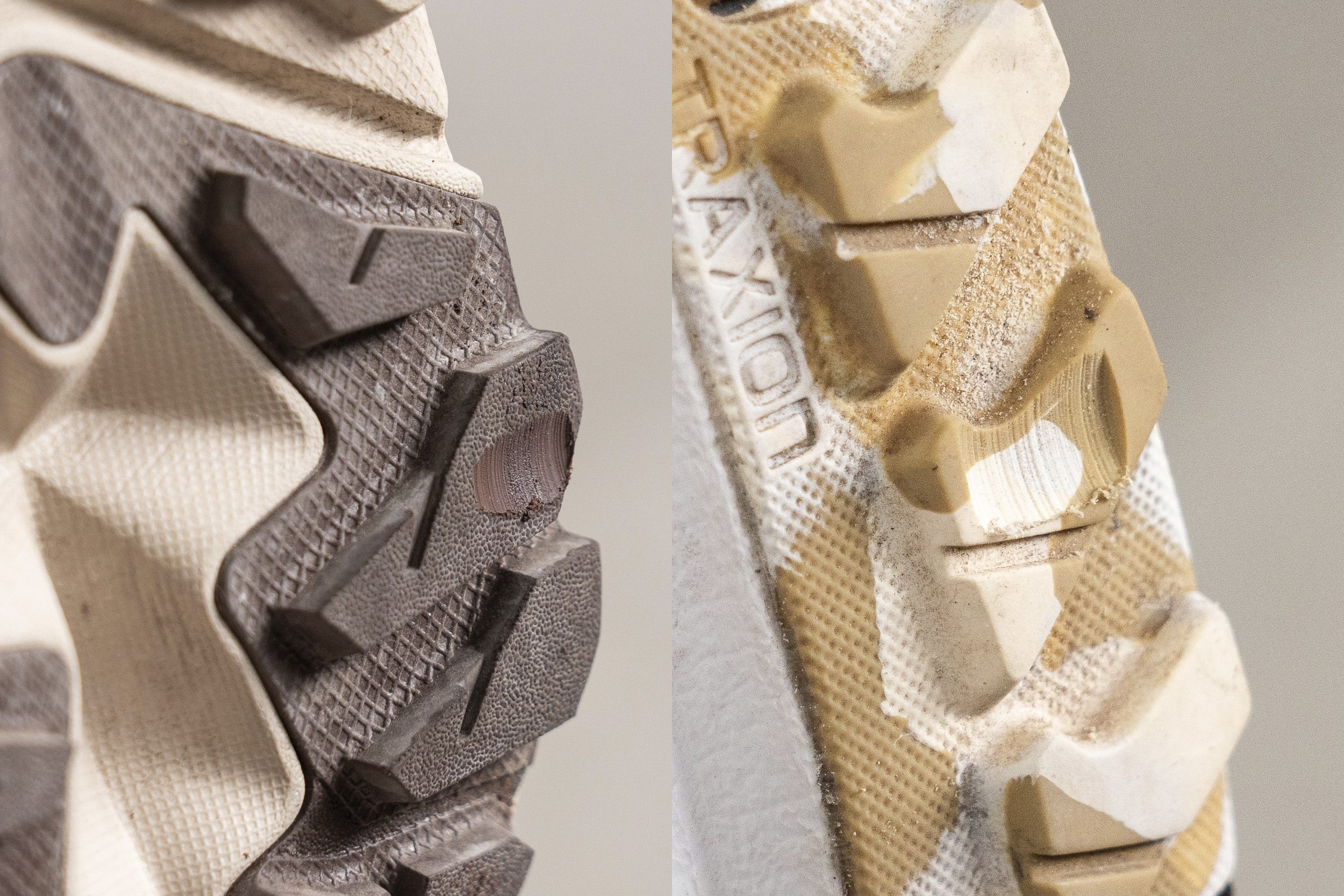
How to find stable and supportive hiking shoes
Stable hiking shoes are usually stiffer and feel more planted. They are great for very demanding terrain, longer hikes, and especially trails covered with sharp rocks or obstacles. In these cases, stiff platforms support the feet and do not make the feet work extra to compensate for all the imbalances and twisting of hiking shoes.
Flexible hiking shoes allow us to experience a more natural hiking feel and are great when we need to be agile and fast. But, on longer hikes, especially the ones on varying terrain and when we’re wearing a heavy backpack, it’s best to look for all the support we can get.
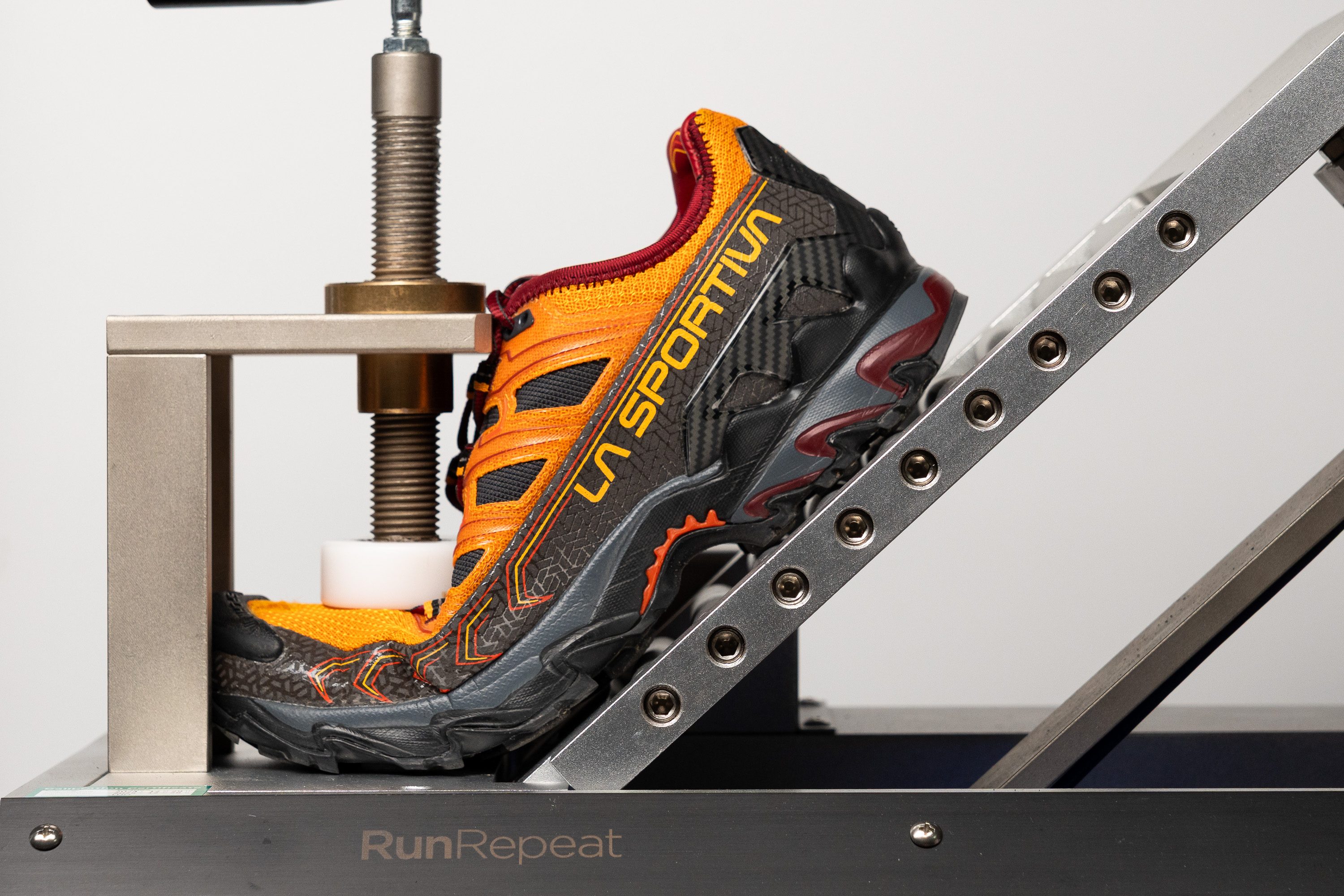
Stable hiking shoes usually have a: a) stiff platform, b) stiff heel counter, and c) wide platform. In our lab, we measure the longitudinal stiffness by bending the shoe to 30 degrees using a stiffness-testing machine. When more force is needed, it means the shoes are stiffer and vice versa, less force means the shoes are more flexible.
When the terrain is uneven, we need stability in all directions, meaning we pay attention to how stiff the platform is both longitudinally (from heel to toes) and torsionally (whether it can be twisted). We twist the shoes and assign them a 1-5 torsional rigidity rating where 5 is the most rigid.
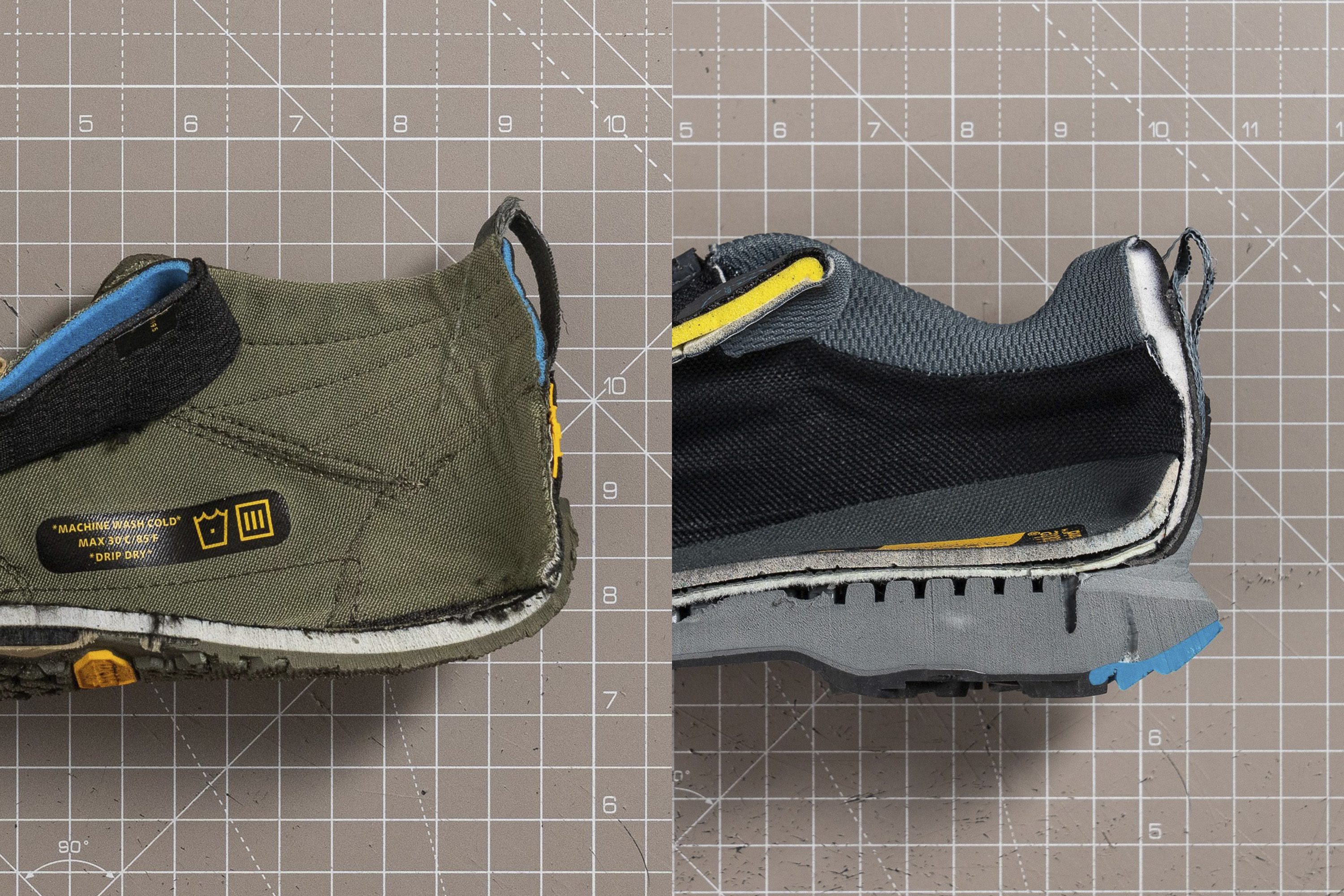
We also assign a 1-5 rating for heel stiffness to every hiking shoe. Stiff heel counters stabilise the heel and help with the overall supportive feel.
And, it’s really important that the platform is on the wide side. We use a digital calliper in our lab to measure the width of the platform both at the forefoot and at the heel.
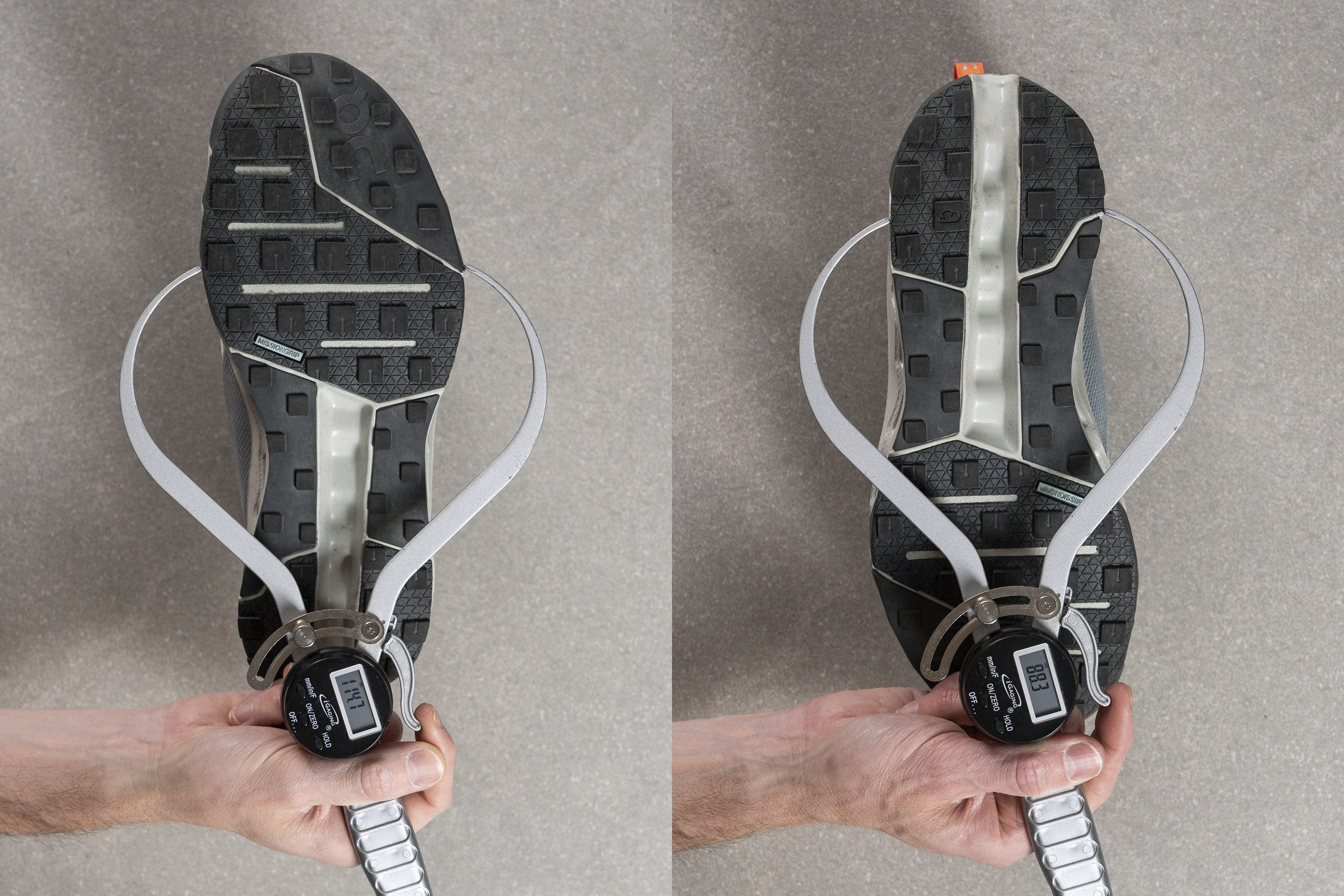
Summer or winter hiking shoes?
Very breathable footwear is great for summer. Very non-breathable footwear is great for winter because it traps the heat. And there are shoes that can work across many or all seasons, all you have to do is adjust the thickness of the hiking socks.
We use a smoke machine to pump the smoke into the shoes and then we look where the smoke comes out and how fast. Watching the smoke come out (or not) allows us to assign a 1-5 breathability rating to every hiking shoe, 5 being the most breathable.
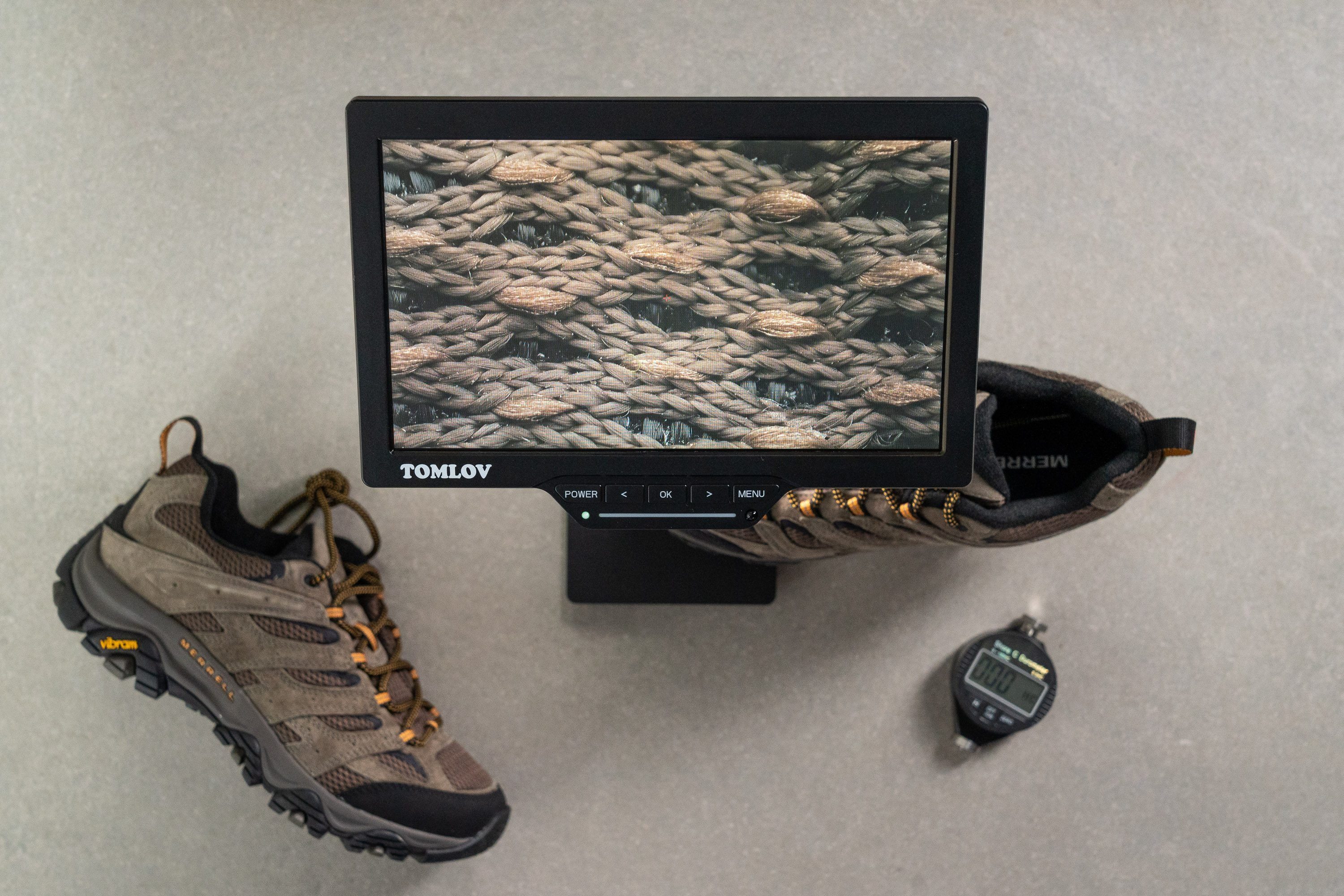
But, we don't stop there. We examine the upper under a microscope. This allows us to understand better the breathability score as we can notice the threads that are loose or tightly packed, if there are any ventilation holes, more layers, and so on.
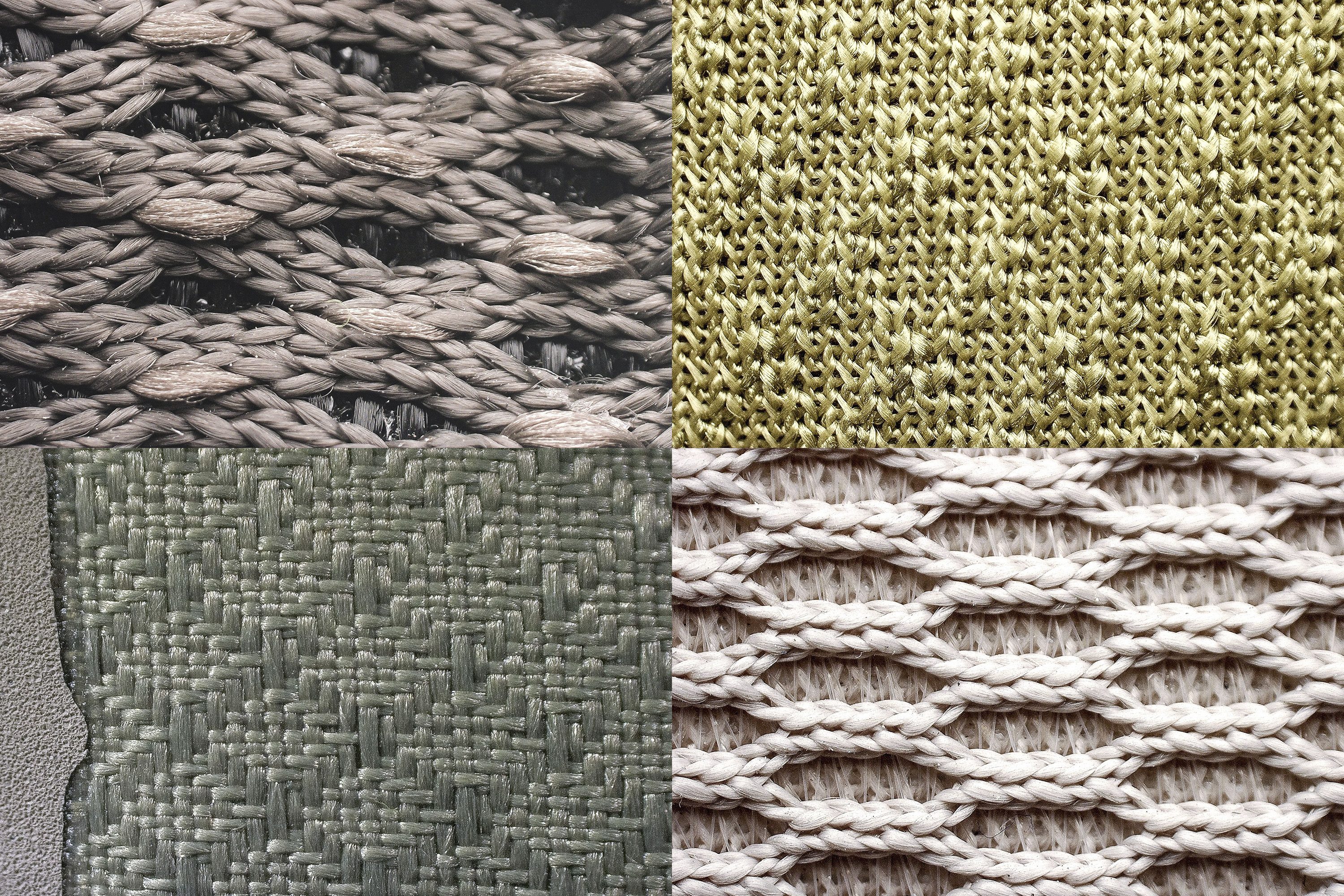
Waterproof hiking shoes for women
Women who plan to hike in wet weather, through the wet grass, in muddy areas, or when it’s raining should consider getting waterproof hiking shoes.
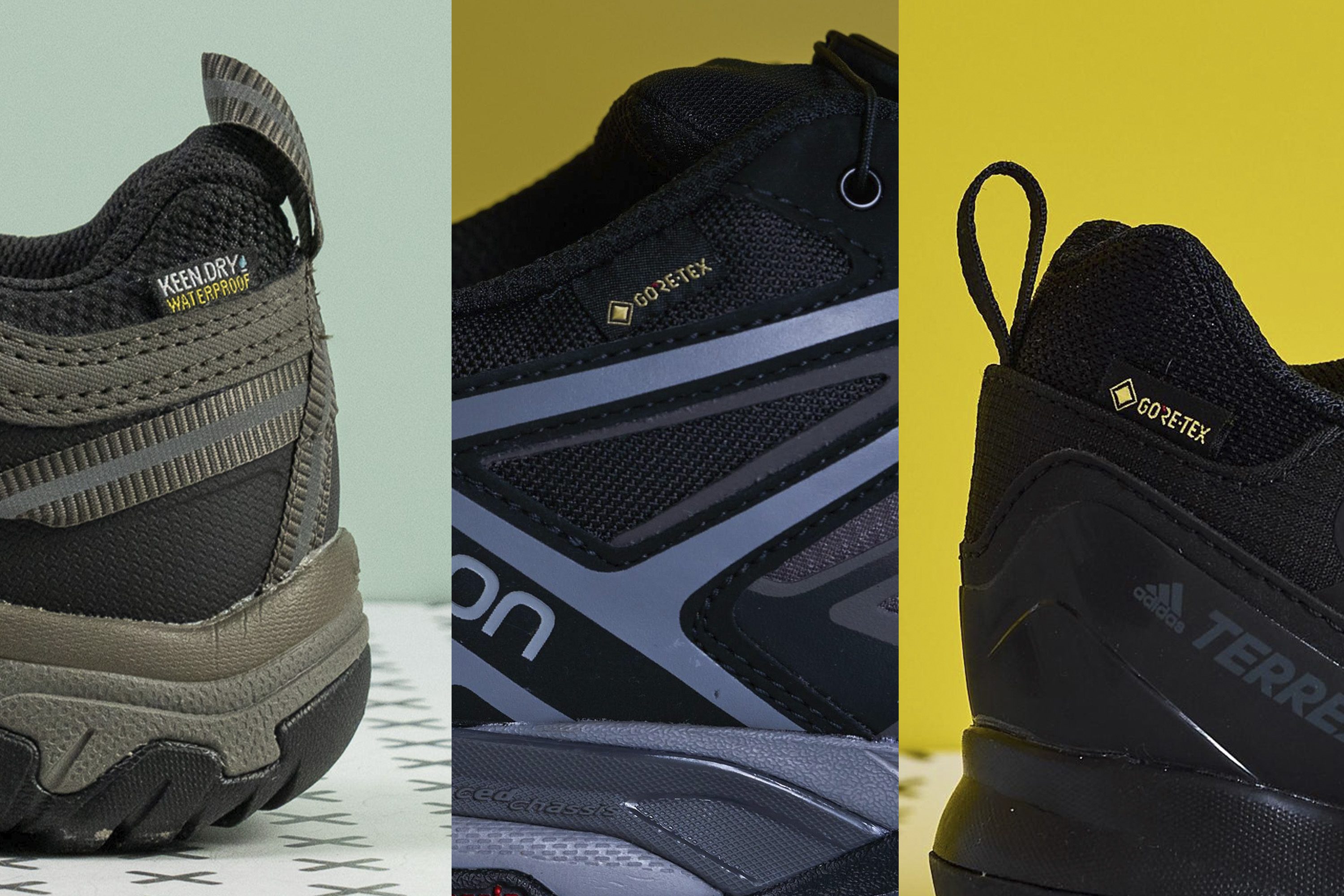
These shoes are always clearly marked as waterproof (or WP), or they have a Gore-Tex (or GTX) sign on the upper, the shoe box, and/or in their name. GTX is the most popular waterproof membrane used in hiking footwear.
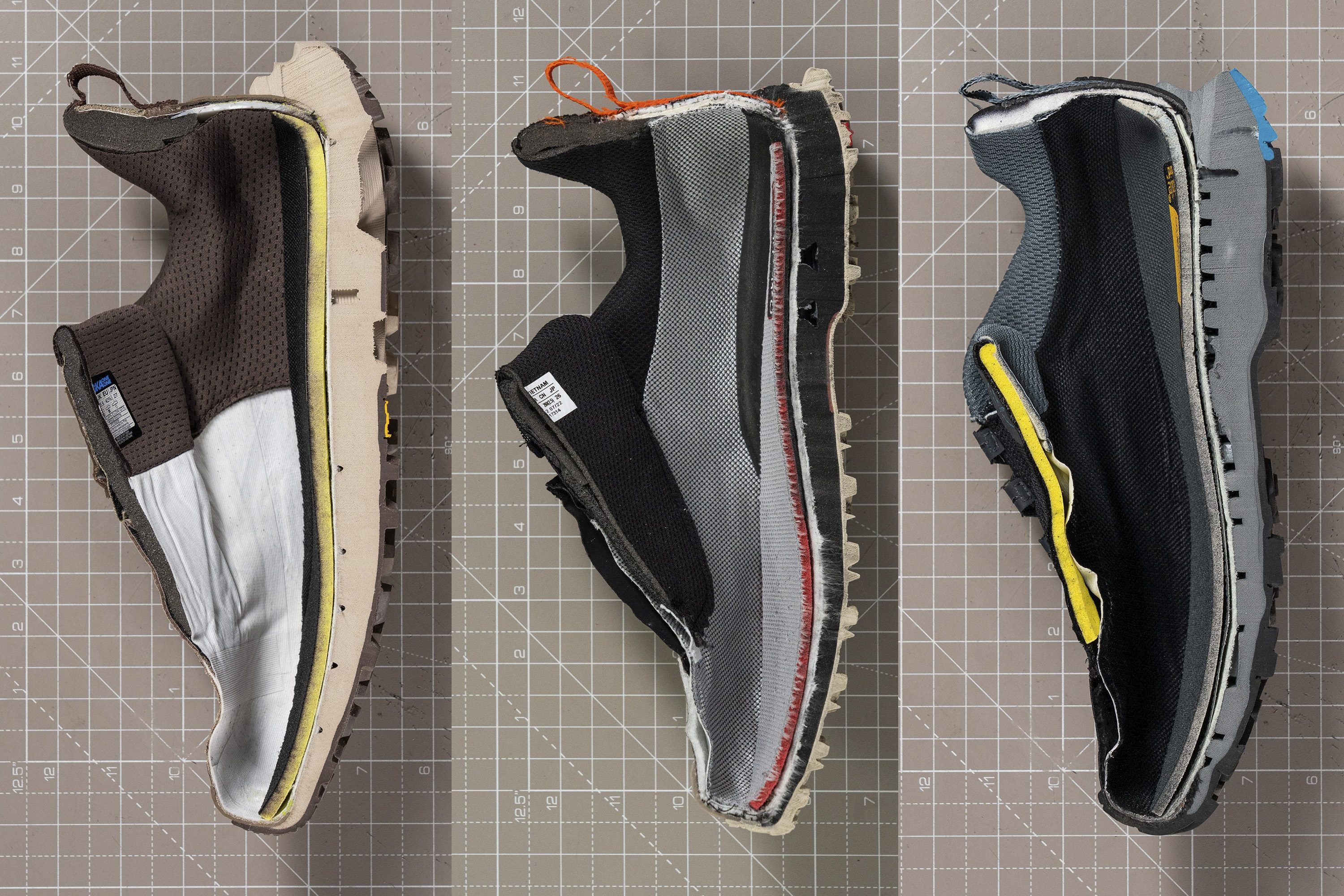
However, we don't recommend buying waterproof hiking shoes if you plan to:
- Hike in mostly dry weather, especially warm weather. Waterproof hiking shoes are not breathable
- Experience rain or wet weather only occasionally. In this case, hiking shoes that dry fast could be a better idea as they will breathe more along the whole hike and they cost less (on average) than waterproof shoes.
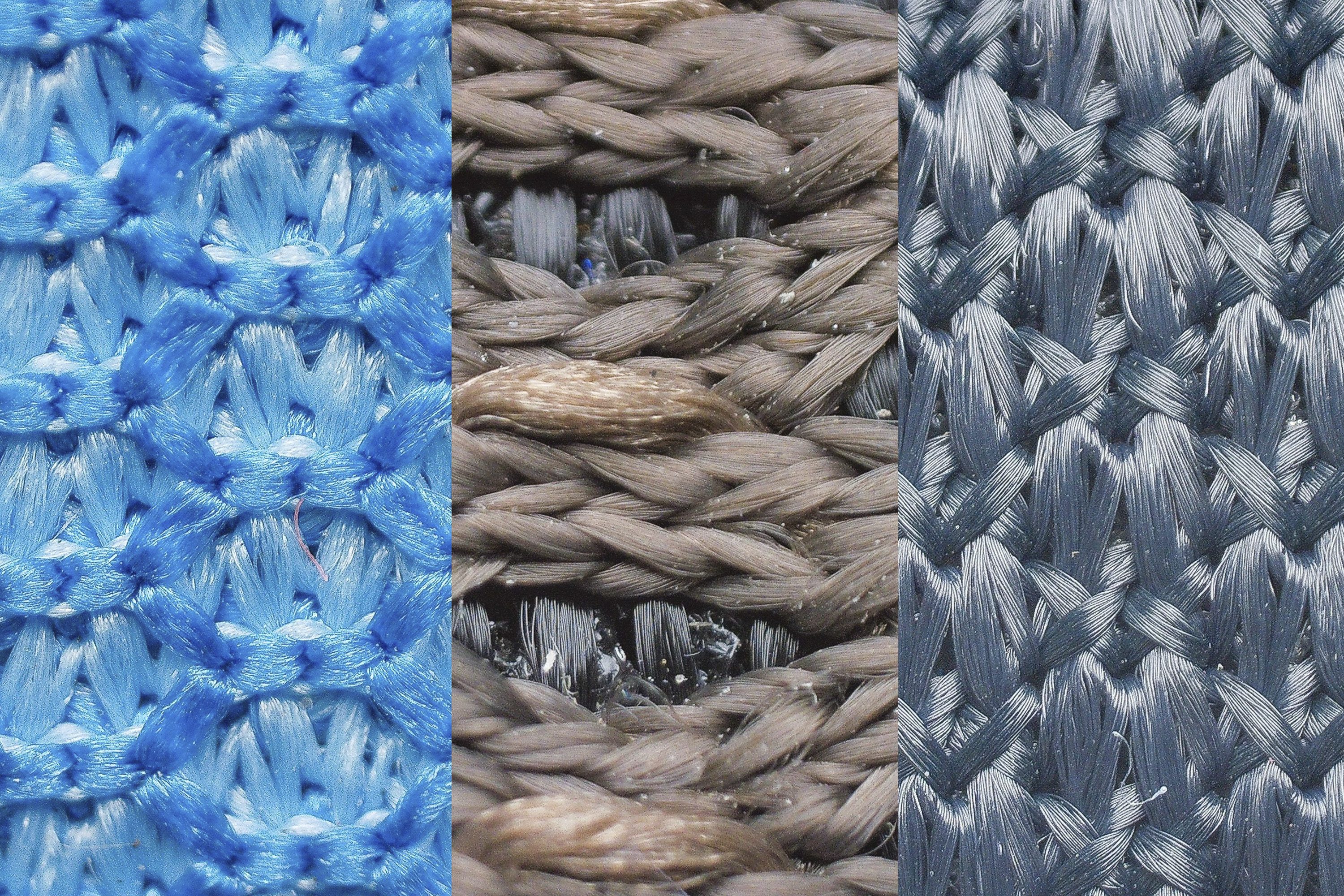
Tips for very wet and rainy weather
Waterproof hiking shoes are great but can only do so much if your hike ends up very very wet. Here’s what we recommend:
- Getting waterproof hiking boots instead of shoes. More protection and you don’t need to worry whether the occasional meet and greet with the water is too deep (over your ankles).
- Getting waterproof gaiters They work great both with shoes and boots. They prevent the water from getting into your footwear and they protect the lower parts of the trousers as well.
- Remember to take care of your waterproof shoes, as the manufacturer suggested. Some uppers might need to be sprayed occasionally, others need cream/wax treatment, etc., depending on the upper material.
Pregnancy and hiking shoes
If you’re pregnant, stability is the priority. We’ve covered this in great detail in the chapter above. Best to look for hiking shoes that have a wide and stiff platform and a great lockdown for your feet. This one can be tricky as you’d also want some room for swelling. Best to choose an upper that has some give but not too much to the point of the shoe being less stable.

